





























































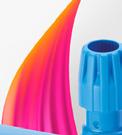






































































































RESEARCH Cleaning and special environments RENEWABLE SOURCES A solution against energy crisis LABOUR MARKET World employment and social outlook CASE HISTORY “Iginio Massari Alta Pasticceria” info@igeax.com | www.igeax.com EVERYTHING YOU NEED TO KNOW ABOUT THE FUTURE OF BRUSHWARE Monthly magazine for industrial sanitization and environmental hygien e S U P P L E M E N T T O D IME N S IO N E P U L ITO N O 8 2 0 2 2 Mont h l y m a g azine fo r in du strial saniti z ation an d envi r onmental h y gien e Let’s talk aboutLet’s talk about Follow US dimensionepulito.it

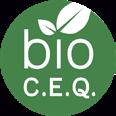
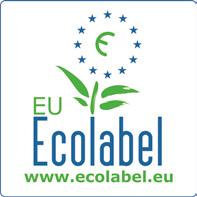

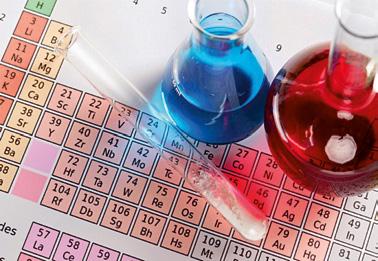



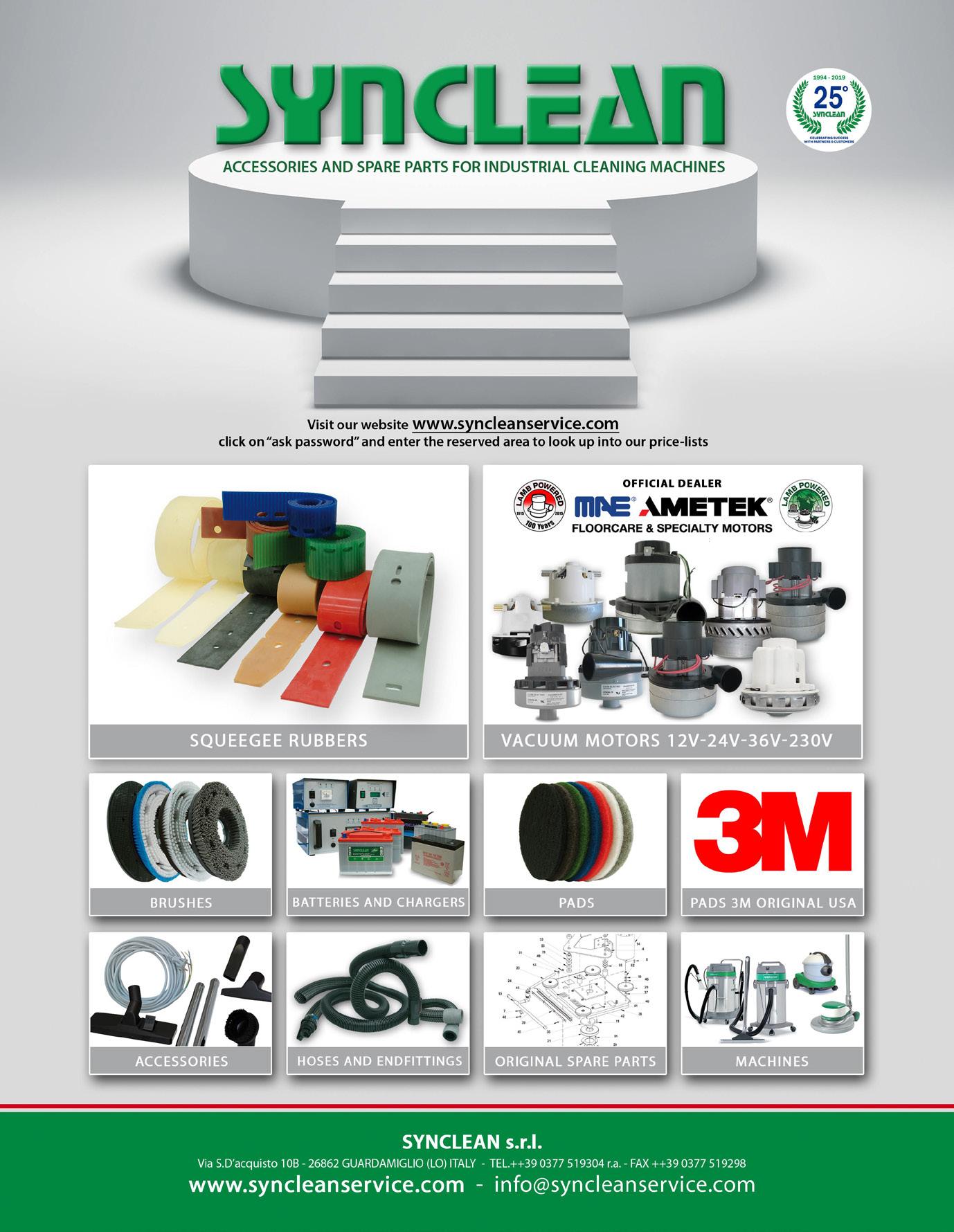
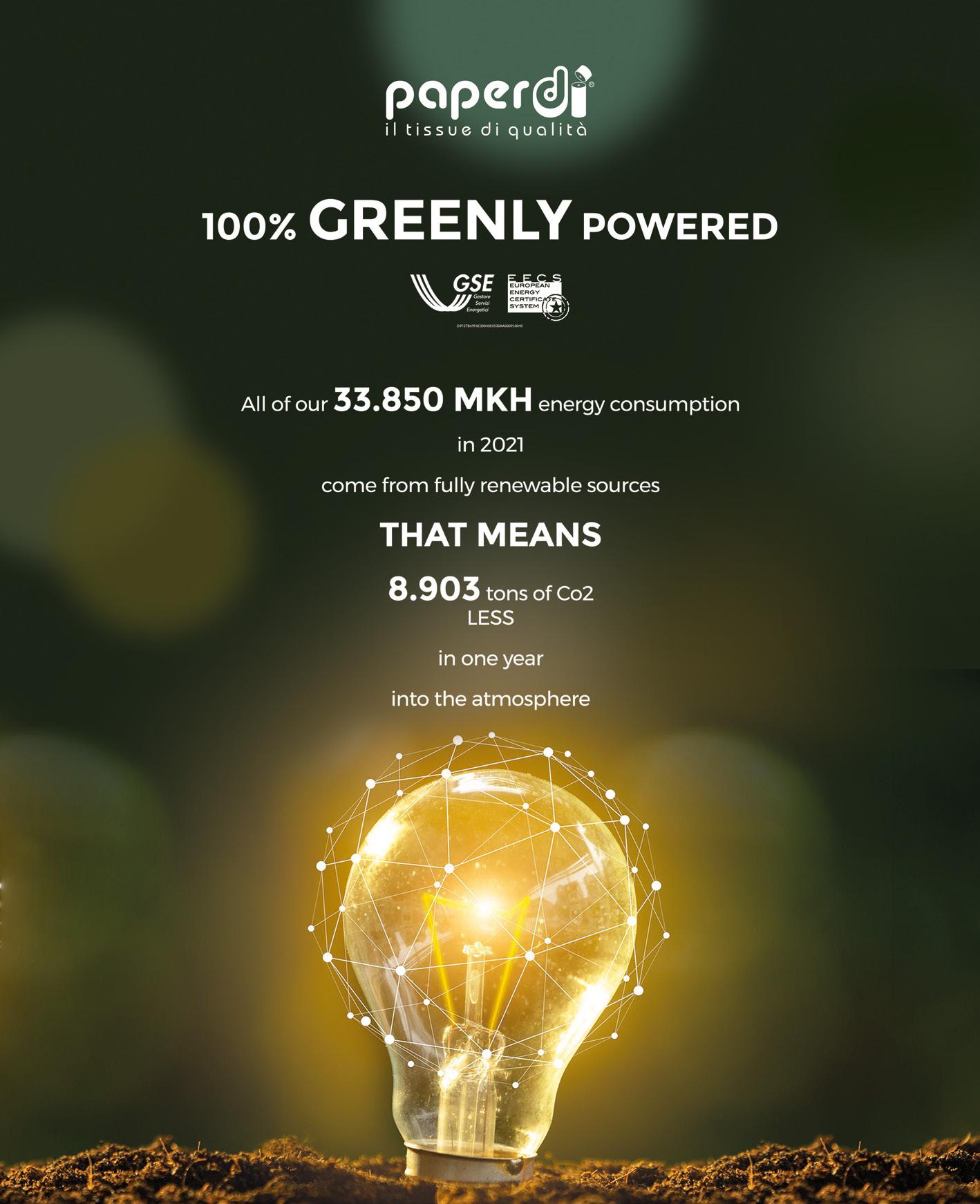
Via G. Spadolini, 7 - 20141 Milano www.quine.it | info@quine.it | Ph. +39 02
Editorial
Ornella Zanetti | ornella.zanetti@quine.it
Technical
Maurizio Pedrini
Editorial
Chiara Scelsi - c.scelsi@lswr.it | Ph. +39 349 0099322

Editors Loredana Vitulano - l.vitulano@lswr.it Ph. +39 342 6618995
Cristina Cardinali - c.cardinali@lswr.it Ph.+39 347 4238879
Simone Ciapparelli - s.ciapparelli@lswr.it Ph. +39 344 0571950
Technical
consultants for
Environmental hygiene Chiara Dassi - Graziano Dassi
Circulations and














service
Ornella Foletti - o.foletti@lswr.it | Ph. +39 342 7968897
Advertising and development dircom@quine.it

Filippo Viola - f.viola@lswr.it Guido Rossi - g.rossi@lswr.it Edoardo Rossi - e.rossi@lswr.it Elena Brusadelli - e.brusadelli@lswr.it
Realizzazione grafica
Paolo Marchetti | Pico Communications SA
Production manager


Antonio Iovene - a.iovene@lswr.it | Ph. +39 349 1811231
Printing Gruppo Logo - Borgoricco (PD) - Italy

















Prices and subscriptions
• Annual subscription: 49 euro




• Subscription outside Italy: 160 euro


• Back copies: 17 euro • Cost of a copy: 1.30 euro abbonamenti.quine@lswr.it | Ph. +39 02 864105 www.quine.it www.dimensionepulito.it
Responsibility
Dimensione Pulito is a Monthly Recorded Periodic: Authorization of the Court of Milan No. 598 of 9.11.92 Quine is registered in the Operators Register of Communication n. 12191 of 29/10/2005. The publication or reprint of articles and images must be authorized in writing by the publisher. The articles published on Dimensione Pulito are under the responsibility of the authors. Published manuscripts and drawings will not be returned.

INFORMATION PURSUANT TO GDPR 2016/679 Pursuant to art. 13 European Regulation for the Protection of Personal Data 679/2016 below GDPR, the data of all readers will be processed both manually and with IT tools and will be used for sending this and other publications and information and promotional material. The methods of treatment will comply with the provisions of art. 5-6-7 of the GDPR. Data may be disclosed to subjects with whom Quine Srl maintains contractual relationships necessary for sending copies of the magazine. The data controller is Quine Srl, Via G. Spadolini 7 - 20141 Milan, to which the reader can turn to request the update, integration, cancellation e any other operation referred to in articles 15-21 of the GDPR.
© Quine srl - Milan






Supplement to Dimensione Pulito No 8 - October 2022 www.dimensionepulito.it
COVER
On January 1st 2022 Ariston Cleaning Solutions became IGEAX: the new brand adds innovation and internationality to the company’s almost centenary experience, specialized in the manufacturing of brushes and similars. IGEAX maintains all the features of the previous brand: the high quality of its products, the flexibility and the prompt services, the constant support between customer and supplier.


RESEARCH
COLLABORATORS
Cristina Cardinali, Simone Ciapparelli, Eugene C. Cole, Luca Ilorini, Marco Monti, Fabrizio Pirovano, Maurizio Pedrini, Alex Pezzin, Loredana Vitulano
ECONOMY
Cleaning and special environments: understanding the science Eugene C. Cole, DrPH





Renewable energies, a shift for a better future




Contents 2412 RESEARCH Cleaning and special environments RENEWABLE SOURCES A solution against energy crisis LABOUR MARKET World employment and social outlook CASE HISTORY “Iginio Massari Alta Pasticceria” info@igeax.com EVERYTHING YOU NEED TO KNOW ABOUT THE FUTURE OF BRUSHWARE Monthly magazine for industrial sanitization and environmental hygien e S L M IME S IO N U ITO O Mont h l y m a g azine fo r in du strial saniti z ation an d envi r onmental h y gien e Let s talk aboutLet’s talk about Follow US dimensionepulito.it
12
Let’s talk about CLEANING
Monthly magazine pubished by Quine Srl
864105 Editor-In-Chief Giorgio Albonetti
director
director
coordination
scientific
the section
subscription
Testata Associata Distribution Quine srl Via G. Spadolini, 7 20141 Milano - Italia Tel. +39 02 864105 Fax. +39 02 70057190 LA GUIDA DA PORTARE SEMPRE CON SÉ PER CONOSCERE TUTTI TRUCCHI DEL MESTIERE LA DISTRIBUZIONE NEGLI IMPIANTI DI RISCALDAMENTO GUIDE dell’Installatore Professionale 7 YOUR INFORMATION PARTNER QUINE COLLABORA CON: www.quine.it Organo ufficiale AiCARR LA RIVISTA PER PROFESSIONISTI DELL’HVAC&R LA RIVISTA PER PROFESSIONISTI DEGLI IMPIANTI HVAC&R Organo Ufficiale AiCARR NORMATIVA Panoramica di inizio anno TAVOLA ROTONDA Conto Termico TEE. che punto siamo? DALLA TEORICA ALLA PRATICA EPB, LE NOVITÀ DELLE NUOVE NORME IMPIANTI AD ARIA PRIMARIA VS VAV FOCUS COMMISSIONING Analisi del processo case study FILTRAZIONE E QUALITÀ DELL’ARIA SOTTORAFFREDDAMENTO ADIABATICO PER LA #42 COMMISSIONING RISPARMIO ENERGETICO NEL TERZIARIO Organo ufficiale ANGAISA LA VOCE PIÙ AUTOREVOLE DEL SETTORE IDROTERMOSANITARIO #251 Bosch riparte CLASSIFICHE 2015 Produttori e distributori: ce la si può fare! FALANGAQuando la differenza TREND bagno che calza pennello www.bluerosso.it LA VOCE AUTOREVOLE DEL CANALE IDROTERMOSANITARIO PIÙ DINAMICA LA PIATTAFORMA ITALIANA DELLA PRODUZIONE MUSICALE E DELL’AUDIO PROFESSIONALE www.audiofader.com WEBSITE AGGIORNATO MAGAZINE MENSILE DIGITALE IVO GRASSO e MASSIVE ARTS Lo studio di modernoregistrazione SALVATORE ADDEO L’amore per l’SSLALTERNATIVI principi programmazione AVID PRO TOOLS DOCKsoluzione per tutti IL PUNTO DI RIFERIMENTO PER CHI OPERA NEL CAMPO DELLA PULIZIA INDUSTRIALE, SANIFICAZIONE E FACILITY MANAGEMENT www.pulizia-industriale.it DA 50 ANNI LA VOCE AUTOREVOLE DEL CLEANING www.casaeclima.com L’INFORMAZIONE EFFICIENTE, COMPLETA E IN TEMPO REALE OLTRE 200.000 UTENTI MESE Organo ufficiale FINCO LA RIVISTA CHE HA PORTATO LA PROGETTAZIONE SOSTENIBILE IN ITALIA MEDAGLIE D’ORO STORIA ITER PROGETTUALE DA NON SOTTOVALUTARE Passo obbligato grande opportunità A SCUOLA DI EFFICIENZA N. 64 Anno dicembre 2016 www.commercioelettrico.comOrgano ufficiale FME IL BUSINESS MAGAZINE DEI DISTRIBUTORI E GROSSISTI DI MATERIALE ELETTRICO DAL 1952 IL PERIODICO D’INFORMAZIONE PER INGEGNERI E ARCHITETTI NEWSLETTER – L’AGGIORNAMENTO PROFESSIONALE VIA MAIL Ogni 15 giorni raggiunge oltre 42.000 iscritti R SPECIALEFOCUS Innovazione e cambiamento Un CNI eletto per dare risposte O miliardo per città In USA volano le infrastrutture Eucentre per ricostruire la sicurezza Ancora trattative consultazioni? I pareri degli Ordini dopo l’esito del referendum del dicembre Newsletter QUOTA RINNOVABILI EDIFICIobblighi e proroghe SCIA, operativoil modello unico Tutti rinvii SPECIALE MILLEPROROGHE Top 7 infrastrutturemegadel 2016 LA RIVISTA PER PROGETTARE LA SMART INDUSTRY Organo ufficiale Confapi INFORMAZIONE TECNICO SCIENTIFICA PER LE PMI www.rivistainnovare.it SUBFORNITURA E ma d u o www.ammonitore.com MENSILE DI FORMAZIONE E AGGIORNAMENTO PER IL MECCATRONICO www.MTEDocs.it INFORMAZIONE TECNICHE PER L’AUTORIPARAZIONE MECCANICA&AUTOMAZIONE PERIODICO BUSINESS TO BUSINESS NEL MONDO DELL’INDUSTRIA MECCANICA E DELLE MACCHINE UTENSILI #4maggio 2016 STORIA DI COPERTINA CAD/CAM unico per settore Lamiera IN QUESTO NUMERO INTERVISTA da quarant’anni Generative design, come Sempre più centro www.meccanica-automazione.com IL PORTALE CHE TI GUIDA VERSO LA SMART INDUSTRY TUTTI VOLTI E LE AZIENDEwww.terminidellameccanica.com IL TRADUTTORE MULTILINGUE DELLA MECCATRONICA URBAN & PARTNER MILANO (I) WRODAW (PL) GALLARATE (I) PIACENZA (I) TIRANA (AL)SARAGOZZA (ES)MILANO (I) Quine srl Via G. Spadolini, 7 20141 Milano - Italia Tel. +39 02 864105 Fax. +39 02 70057190 YOUR INFORMATION PARTNER QUINE COLLABORA CON: www.quine.it DELL’HVAC&R 42 Organo ufficiale ANGAISA LA VOCE PIÙ AUTOREVOLE DEL SETTORE IDROTERMOSANITARIO Poste italiane Target Magazine LO/CONV/020/2010 Omologazione DCOCI0168 #251 da… Bosch CLASSIFICHE 2015 Produttori e distributori: ce la si può fare! ANTONIO FALANGA Una passione sempre viva DISTRIBUZIONE Quando differenza TREND bagno che ti calza pennello FOCUS Un anno di logistica www.bluerosso.it LA VOCE AUTOREVOLE DEL CANALE IDROTERMOSANITARIO PIÙ DINAMICA LA PIATTAFORMA ITALIANA DELLA PRODUZIONE MUSICALE E DELL’AUDIO PROFESSIONALE www.audiofader.com WEBSITE AGGIORNATO QUOTIDIANAMENTE MAGAZINE MENSILE DIGITALE IVO GRASSO e MASSIVE ARTS Lo studio di modernoregistrazione SALVATORE ADDEO L’amore per l’SSL principi programmazione AVID PRO TOOLS DOCKla soluzione per tutti IL PUNTO DI RIFERIMENTO PER CHI OPERA NEL CAMPO DELLA PULIZIA INDUSTRIALE, SANIFICAZIONE E FACILITY MANAGEMENT www.pulizia-industriale.it DA 50 ANNI LA VOCE AUTOREVOLE DEL CLEANING www.casaeclima.com L’INFORMAZIONE EFFICIENTE, COMPLETA E IN TEMPO REALE OLTRE 200.000 UTENTI MESE Organo ufficiale FINCO LA RIVISTA CHE HA PORTATO LA PROGETTAZIONE SOSTENIBILE IN ITALIA SAIE INNOVATION 2016 FOTOVOLTAICO INTEGRATO UNA SCELTA Passo obbligato grande opportunità A SCUOLA DI EFFICIENZA 64 Anno dicembre 2016 www.commercioelettrico.comOrgano ufficiale FME IL BUSINESS MAGAZINE DEI DISTRIBUTORI E GROSSISTI DI MATERIALE ELETTRICO IL PERIODICO D’INFORMAZIONE INGEGNERI E ARCHITETTI L’AGGIORNAMENTO PROFESSIONALE VIA MAIL raggiunge oltre 42.000 iscritti FOCUS politico barcolla, alta l’attenzione sul governo degli ingegneri eletto per dare risposte In USA volano le infrastrutture Eucentre per ricostruire la sicurezza Ancora trattative e consultazioni? Newsletter Programma Corsi di Aggiornamento Professionale RINNOVABILI EDIFICIobblighi e proroghe → pag.37→ pag.3 modellooperativo unico Tutti rinvii SPECIALE MILLEPROROGHE Top infrastrutturemegadel 2016 LA RIVISTA PER PROGETTARE LA SMART INDUSTRY Organo ufficiale Confapi INFORMAZIONE TECNICO SCIENTIFICA PER LE PMI www.rivistainnovare.it MENSILE PER LA SUBFORNITURA E LA PRODUZIONE INDUSTRIALE c n e p m d t www.ammonitore.com MENSILE DI FORMAZIONE E AGGIORNAMENTO PER IL MECCATRONICO www.MTEDocs.it INFORMAZIONE TECNICHE PER L’AUTORIPARAZIONE MECCANICA&AUTOMAZIONE PERIODICO BUSINESS TO BUSINESS NEL MONDO DELL’INDUSTRIA MECCANICA E DELLE MACCHINE UTENSILI #4maggio 2016 STORIA DI COPERTINA CAD/CAM unico per settore Lamiera IN QUESTO da quarant’anni Generative design, comecambierà mondo SPECIALE Sempre più centro dello sviluppo Macchine misura www.meccanica-automazione.com IL PORTALE CHE TI GUIDA VERSO LA SMART INDUSTRY TUTTI I VOLTI E LE AZIENDE DELLA MECCATRONICA URBAN & PARTNER MILANO (I) WRODAW (PL) GALLARATE (I) PIACENZA (I) TIRANA (AL) 1. Dealers 2. Service companies 3. Food industry 4. Healthcare 5. Public bodies 6. Public businesses 7. Hotellerie 8. Professional laundries 9. Pest management and environmental services 10. Large distribution
Maurizio Pedrini 24







Green economy, a challenge for industry and society Maurizio Pedrini


LABOUR MARKET
The world employment and social outlook Cristina Cardinali
CASE HISTORY
Cleaning is at home at “Iginio Massari Alta Pasticceria” Maurizio Pedrini
INDOOR AIR QUALITY

Air aromatisation and purification Luca Ilorini
Quality makes the difference Marco Monti and Fabrizio Pirovano

CONTENTS 32 40 42 48 52
32 ENVIRONMENT
MARKETING 40 42 48


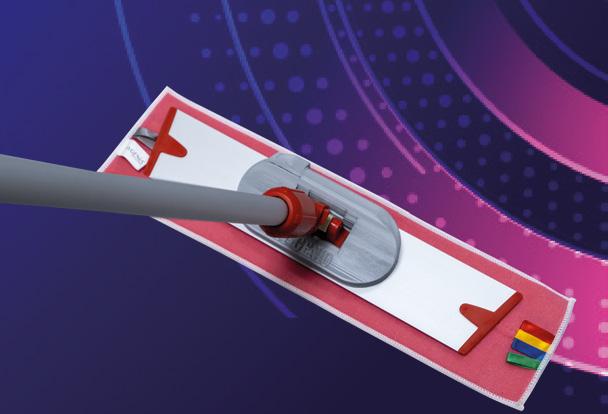














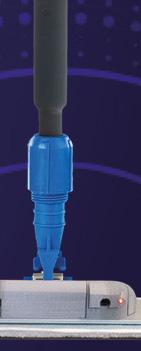






PEST CONTROL
54 60
West Nile Virus, a treatment against mosquitoes Alex Pezzin
ON THE MARKET TODAY
Technologies, research and development: the new products in the world of cleaning Cristina Cardinali

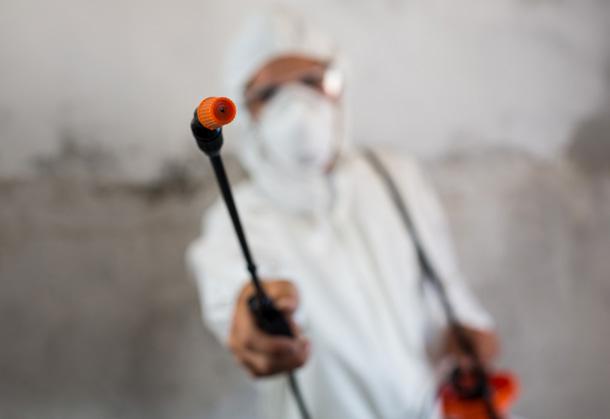
INDEX OF ADVERTISERS
4CleanPro 30, 31
Arco Inside cover, 60
Comac 20, 21, 60
Falpi 23, 60
Fimap Back cover, 37 Hygenia 10, 60

Igeax Front cover, 38, 39
Kemika 3, 60
Klindex Inside back cover, 60
MP-HT

Orma
Paperdi
Parodi&Parodi

Rubino Chem
60
60
Spray Team 58, 59, 60
Synclean
Tenax
CONTENTS
47, 54
51,
6, 54
11,
8, 54
4, 5, 60
66 54 C M Y CM MY CY CMY K pubblicità GSA115x150.pdf 1 26/03/15 15.27
Cleaning and Special Environments Understanding the Science
Eugene C. Cole DrPH
Special environments are those that harbor individuals who are considered susceptible to nega tive health effects associated with the accumulation of indoor contaminants and pollutants, and therefore pres ent a notable challenge. They include schools, daycare, healthcare facilities (e.g.,hospitals, rehabilitation centers and long-term care facilities [LTCFs]), and some home environments. Such populations include individuals with severe allergies and hypersensitivities, to include asthma, as well as those who are immunosuppressed or immu nodeficient and therefore at-risk for a variety of potentially life-threatening
opportunistic infections caused by otherwise innocuous indoor contam inants such as environmental molds. Children and especially young children have immature immune and organ sys tems and are therefore at risk during their growth and development, especially from pollutants such as heavy metals and chemical residues that may be present in everyday house dust. Similarly at risk are the elderly, with their waning immune function and susceptibility to drug-re sistant bacterial pathogens and respira tory viruses, in conjunction with a variety of chronic illnesses that often renders them even more vulnerable to indoor en vironmental contaminants.
This article is reprinted with permission from the issue 4, volume 1, of the Cleaning Science Quarterly, the official peer-review journal of the Cleaning Industry Research Institute (CIRI).
THE INDOOR ECOSYSTEM
Each indoor environment is an artificial ly created ecological system comprised of a nonliving or physical component intertwined with a living or biological one. The physical environment includes structural, finishing and furnishing ma terials, and their paints, coatings and sealants, a variety of contents, and a cli mate as measured by temperature, rela tive humidity and airflow. The living or biological indoor environment typically includes microorganisms, insects, plants, rodents, pets and humans. This indoor ecosystem is comprised of an interre lated complex of smaller microenviron ments or habitats, each of which has its
12 RESEARCH OCTOBER 2022
Understanding the complexities of special environments is necessary to provide a basis of guidance for cleaning and restoration professionals
SYNOPSIS
Cary, NC; and Young University, environments, with special evaluation, cleaning been a contributor Standard and the Science degree in Biohazard Science Chapel Hill. He is a

own mix of physical and biological fac tors, and can serve as reservoirs for a variety of pollutants that can potentially affect the quality of the air in occupied spaces. Some microenvironments are structural components such as interior and exterior wall cavities, ceiling spaces, air-handling systems, and crawlspaces. Others serve as reservoirs that readily collect particulates such as dust, fibers,
soil, and debris that can harbor a variety of chemical and biological pollutants, such as pesticide and lead residues, along with microbial, insect and animal allergens. Examples of such microen vironments include textile floor cover ings, upholstered and hard surface fur nishings, bathroom surfaces, and food preparation and pet areas. If the accu mulating particulate burden of these res
ABOUT THE AUTHOR
Dr. Cole is Director of Research for LRC Indoor Testing & Research, Cary, NC, and formerly Professor of Environmental Health Sciences at Brigham Young University, Provo, UT.

His research focuses on the ecology of indoor environments, with special emphasis on identification and reduction of pollutant reservoirs and sources, bioaerosols, human exposure assessment and control, product evaluation, cleaning and restoration, mold and sewage remediation, and biocides.
ervoirs is not regularly reduced through a removal process known as cleaning, they may quickly become sources of in door contamination through airborne dissemination resulting from occupant activity and mechanical airflow. Such dissemination can seed previously un contaminated areas as well as degrade air quality, leading to occupant expo sures and adverse health effects in sus ceptible individuals. The latter, in par ticular, are considered at-risk in the aforementioned special environments that present significant cleaning chal lenges. The general population often incurs health risks in high occupancy indoor environments such as office buildings, hotels, and cruise ships. The focus of this discussion will be on spe cial environments. However, the home, where everyone typically has their highest occupancy time, presents the greatest risk because reservoir reduc tion through cleaning is often the least well managed. Many of the principles cov ered here also apply to home cleaning.
for inspection, cleaning and maintenance of all components, including filters, cooling coils and ductwork. animals in schools, while valuable to learning, are of environmental pollution. The primary exposure classrooms harboring animals is from airborne allergens. minimize exposures to allergic and infectious agents, should dedicate one room as an animal room, thus active pollutant sources from the classrooms and
13OCTOBER 2022
CLEANING
Cleaning is a systematic, science-based process of managing unwanted matter, so human activities can take place in a healthy environment2. Effective cleaning requires an understanding of the science of particulate deposition and retention on various surfaces. Effective cleaning also chooses those practices and proce dures necessary for maximizing pollut ant removal while containing the process and minimizing cross-contamination. In all cases, cleaning needs to maintain and preserve the integrity of the surface or material being treated. It is heavily dependent on frequency of implementa tion and the efficiency of the equipment and cleaning products being used.
SCHOOLS
Public school facilities present a par ticular challenge in regard to cleaning and overall environmental management
due to budget constraints and resultant shortages of facilities maintenance and janitorial staff, outdated and ill-function ing cleaning equipment, and poor clean ing products and staff training. Addition ally, many schools are poorly designed and constructed, and ageing, making ad equate inspection and appropriate sub sequent cleaning a significant challenge. Thus, not surprisingly, available evidence suggests that poor indoor environmental quality (IEQ) in schools is common and adversely influences the performance and attendance of students, primari ly through health effects resulting from exposure to indoor contaminants and pollutants3. Lack of proper cleaning permits dust-collecting reservoirs to be come sources of insect, animal, and mi crobial antigens that can trigger asthma and respiratory allergies, and possibly induce respiratory inflammation, which may predispose students to infectious
respiratory illness, especially during the cold and flu season.4, 5, 6, 7
Major dust reservoirs/sources in schools that typically lack effective cleaning and maintenance include carpet, animal cag es, and HVAC systems. Additionally, inat tention to moisture intrusion or accumu lation throughout a facility may lead to microbial growth and quality and greater student exposures to respiratory health risks. On the positive side, the value of ef fective cleaning has been demonstrated, as increased effort at improved cleaning of floors and desks in schools has actu ally been demonstrated to reduce upper respiratory symptoms8
Cleaning for Health. Recent studies have collectively indicated that enhanced hy giene in schools, and targeted cleaning of biological residual contamination re lated to frequent-contact points, result ed in reduced illnesses tied to bacterial contamination reservoirs (MRSA, shigella
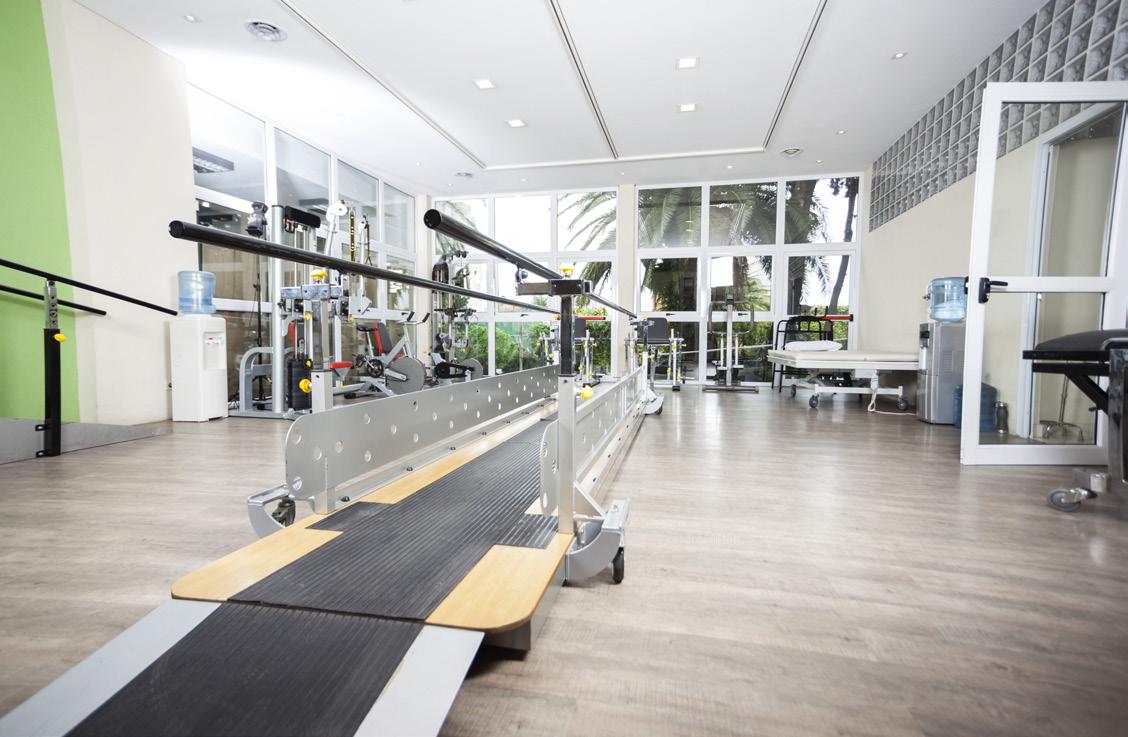
14 RESEARCH OCTOBER 2022
outbreaks), reduced sick building syn drome symptoms, and reduced absen teeism due to infectious illnesses9, 10, 11, 12
And while school hygiene programs such as handwashing promotion are admira ble and well-intentioned, they typically neglect the rapid recontamination of hands via high contact touch points that are usually poorly cleaned. Thus, stu dent illness and absenteeism rates fail to change13, 14
While classrooms and hallways remain major dust reservoirs in school build ings, other subcompartments of the ecosystem (e.g. food preparation areas, restrooms, locker rooms, gyms) require similar attention to cleaning, with an additional targeted focus on reducing the infectious disease potential. School kitchens and related areas, as obligated by public health code, must be cleaned and sanitized to prevent environmental contamination and transmission of bac

terial pathogens such as E. coli, Listeria, and Salmonella. Similarly, restrooms must be effectively cleaned and monitored for effectiveness to prevent exposure and re sultant student illnesses from a variety of pathogens, both enteric (e.g. norovirus es, E. coli) and respiratory (e.g. cold, flu viruses). This is emphasized by results of a study in two daycare centers where 19% of surfaces tested were positive for rotavirus15. Rotavirus contamination was found on drinking fountains, water play tables, toilet handles, and telephone re ceivers. There can also be other conse quences associated with poor cleaning of school restrooms, with students de scribing them as “unpleasant,” “dirty,” “smelly,” and “frightening,” and refusing to use them while at school, thus suffer ing consequences such as constipation, urinary tract infections, and inconti nence16, 17
Likewise, school locker rooms and gym
nasium surfaces and materials, if improp erly cleaned and sanitized, can increase transmission of infectious agents such as athlete’s foot fungi, Staphylococcus au reus, and Herpes viruses. Absent effective cleaning, there is the potential for wide spread outbreaks among students, as occurred with methicillin-resistant S. au reus (MRSA) in a college football team18 A recent extensive review of the signifi cance of fomites (inanimate surfaces) in the spread of respiratory and enteric viral disease, stated that “the rapid spread of viral disease in crowded indoor estab lishments, including schools, day care fa cilities, nursing homes, business offices, and hospitals, consistently facilitates dis ease morbidity and mortality.” Further, it concluded that “level of cleanliness” is one of a number of factors involved19
Carpet. Although carpets in schools are usually cleaned by an extraction pro
15OCTOBER 2022
cess once each year, the lack of effective maintenance with efficient vacuuming throughout the year permits the carpet dust reservoir or “sink” to fill and be come a source. Carpeted classrooms are typically crowded with student desks and other furniture, and manpower is usual ly lacking to rearrange it to effectively vacuum the carpet even once per week. Additionally, some vacuum cleaners are inefficient at dust capture and lack ap propriate exhaust filtration. Thus they serve as aerosol generators, collecting carpet dust and its pollutants, and aero solizing them back into the environment. As carpet becomes a source, children can be exposed to very fine or respirable par ticles (<0,5 µm) which may contain a va riety of allergens from dust mites, cock roaches, and cats (as antigens are brought to school on clothing and shoes), as well as spores from allergenic molds such as
Cladosporium, Penicillium, and Aspergil lus. Research has shown that even dust from well-maintained carpet can harbor in excess of 1.5 x 105 mold spores and 1.0 x 107 bacteria per gram of carpet dust20 Thus, if carpet has been water damaged from moisture intrusion or damp from inefficient cleaning methods for more than 24 hours, the fungi and bacteria will grow and amplify rapidly. In this situa tion, the carpet’s burden of fungal con tamination, primarily as mold allergens, along with potential toxic metabolites (mycotoxins) increases significantly, as does the bacterial burden and its source of endotoxins (bacterial cell wall compo nents that react with lung tissue and are associated with respiratory illness). The latter can induce fever, increase reactivity of the airways, and induce bronchocon striction and chest tightness. Endotoxins also have the potential to boost respons
es to inhaled antigens21
Chemical pollutant exposures may oc cur as children are exposed to respirable carpet dusts containing residues of pol lutants such as pesticides, cleaning prod ucts, lead, and various volatile organic compounds (VOCs) produced by micro bial contamination. A “musty”, “moldy”, “mildewy” odor is definitive for microbi al contamination of carpet. Additionally, carpet may serve as a fomite or mechani cal means of transmission of agents such as head lice or fungi that cause skin infec tions, such as ringworm. These are signif icant risks for children in the lower grades who might sit or lie on carpet for most of the school day. In a study sponsored by the U.S. Environmental Protection Agen cy (EPA), indoor air quality monitoring for biological pollutants was conduct ed before and then during professional carpet cleaning in 16 commercial, public

16 RESEARCH OCTOBER 2022
and residential environments22 The sites included six clerical offices in high-rise buildings, four service-based business offices at ground level, five single-family homes, and one elementary school class room. The data showed a strong relation ship between the routine cleaning and maintenance of carpets and resultant low levels of airborne fungi. The lowest level of airborne fungi were in the clerical offices,and the highest were in the homes and the school. The clerical offices were rigorously maintained by daily vacuum ing, monthly shampoo or bonnet clean ing, and regular (every 12–18 months) hot water extraction. The offices also had reduced track-in contamination by be ing above ground level, without animals or children. Conversely, the homes and school classroom were at ground level, had multiple pollutant sources, and per haps most importantly, were infrequent ly cleaned and vacuumed. Those results dramatically demonstrated the effort required to maintain carpet in a healthy state and prevent it from becoming a pollutant source. Extraction cleaning should be done periodically according to the industry standard for professional cleaning of textile floor coverings23. The standard calls for ensuring that carpet is dried as quickly as possible to prevent microbial amplification. After cleaning, carpet should be maintained by frequent vacuuming with high efficiency vacuum cleaners that provide maximum extrac tion and minimum dust resuspension to the air. Careful attention to carpet clean ing, maintenance, and moisture control provides the preventive care necessary to keep the carpet sink from becoming a pollutant source. Unfortunately, as men tioned previously, the monetary and per sonnel resources needed to implement such a program in a school environment are usually lacking. Therefore, serious consideration must be given to the ques tion of whether or not to install carpeting in school buildings. While hard surface flooring will still require routine cleaning and maintenance to reduce pollutants at comparable costs, it will often reduce the
potential for an often neglected source in the classroom.
Heating, ventilating, and air-conditioning system (HVAC). In a 15-year-old school building, 50% of the occupants com plained of a building-associated illness characterized by eye, nose, and throat irritation, skin rash, headache, and fa tigue24. Complaints included a musty odor during the air-conditioning season. Air-handling unit plenums and major air supply ducts were lined with a porous in sulation. Due to deficiencies in air filtra tion, the insulation had become perme ated with organic dusts after many years. Insulation downstream of the cooling coils became amplification sites for fun gi, such as Penicillium, and bacteria such as thermophilic actinomycetes. Both produce spores that can be deposited in the upper and lower airways and result in a variety of respiratory illnesses. Airborne concentrations of those microorganisms in classrooms and offices were up to 100 times those found in the outdoor air. The acoustical insulation inside air-handling units and air supply ducts functioned as amplification sites for microorganisms. The key to preventing air duct-related pollution problems in school build ings is a combination of proper design and dedicated inspection, cleaning and maintenance. First and foremost, inter nal porous insulation should be preclud ed from use in ductwork. Even if a sealed liner is used internally, it still maintains the possibility of entrapping dust and debris, and it also complicates the com mercial duct cleaning process. Ducts can be insulated externally using fiberglass wrap. If internal porous insulation is determined to be a source of microbial contamination, it should be removed or the ductwork replaced, as opposed to the use of antimicrobials, biocides, sealants/ encapsulants - although the latter may be beneficial in unique circumstances.
Additionally, components of the HVAC system must be designed and construct ed to provide access for easy inspection, cleaning and maintenance of all compo nents, to include filters, cooling coils and
duct-work. Access doors should be large and easy to open to facilitate thorough and regular maintenance. Hinged access doors are preferable to bolted access panels, and condensate drain pans must be designed to completely drain. Many pans are still designed and manufactured with the bottom of the drain hole above the bottom of the pan, always ensuring enough of a water reservoir to produce a microbial soup whose contaminants can be entrained into the building airflow. As research is still incomplete regarding ef ficacy of the variety of commercial duct cleaning practices available to mitigate duct-related problems, emphasis for en suring a healthy school building should focus instead on prevention of pollutant problems through attention to design intervention and subsequent routine in spection, cleaning and maintenance.
Animals in school environments. Small an imals in schools are recognized as valua ble to the learning process. They are aids to children learning principles of various disciplines including among others, biol ogy, ecology, environmental science, be havior, geography and even mathematics. They are also sources of environmental pollution that must be addressed. His torically, teacher classrooms in elemen tary and middle schools harbor a variety of small animals such as hamsters, mice, guinea pigs, chinchillas, ferrets, rabbits, snakes, lizards, turtles, chicks, ducklings and others. Children are afforded oppor tunities to observe, feed, weigh, pet and otherwise handle and care for these ani mals in order to have meaningful life and educational experiences. While teachers must assume responsibility for providing an optimum environment for the ani mals, and preventing their mistreatment, they must also realize the potential for adverse health effects to the children in terms of allergic and infectious diseas es. The most insidious exposure affect ing children in classrooms harboring animals, especially mammals, is from allergens by the airborne route. Dander from the animals as well as fungal and
17OCTOBER 2022
bacterial spores and toxins from fecal and bedding materials may induce or ex acerbate allergic sensitivities. Asthma in elementary school children is the leading cause of school absences, and a major public health concern. Inflammation and irritation of the upper airways as a result of allergen exposure may increase sus ceptibility and other viruses, as well as bacterial infection such as streptococcal
the determination of the required heat ing, cooling, ventilation and cleaning and maintenance is simplified.
Design for a healthy school building. First and foremost, the entire question of cleaning the school building, to include decisions on floor coverings, animals, and access to the HVAC system, must be addressed in the building’s design phase.
Design intervention is a useful strategy
species. Patients with active tuberculo sis can be housed in negative-pressure rooms, required to wear respiratory pro tection, or placed in laminar-flow beds until shown to be non-infectious. En vironmental sources can be managed through a program of building mainte nance that ensures appropriate and rou tine inspection of potential sources, such as HVAC air intakes and filter banks, air
sore throat. Animals also have the poten tial to transmit infectious agents through direct contact, such as those causing sal monellosis and fungal infections of the skin.
In order to minimize day-long exposures to allergic and infectious agents, it is rec ommended that schools dedicate one room to be an animal room, thus taking active pollutant sources from the class rooms and facilitating the cleaning pro cess. The room will have adequate cage racks, as well as mechanisms for con venient feeding, watering and cleaning chores. Most importantly, the room will have a dedicated system of exhaust ventilation to carry dusts, dander, allergens, and odors directly out of the building. Teach ers can periodically bring students to the animal room for the required observation or experimentation, rather than having the students exposed continually in the classroom. Rather than face difficulties later in attempting to retrofit an area as an animal room, the concept should be addressed in the design phase of a new building or planned renovation, when
for controlling pollution indoors when it becomes necessary to match the built environment with the activities that take place inside. Design intervention is im portant when designing new buildings as well as when remodeling an old structure for new use. Buildings and their furnish ings need to be designed in a way so they can be cleaned, with cleaning defined as maximizing the removal of pollutants while minimizing chemical, biological, particle and moisture residues24,25.
HEALTHCARE FACILITIES
Hospitals and long-term care. A major challenge for hospitals and long-term care facilities (LTCFs) is prevention of transmission of infectious disease agents resulting in healthcare-associated (or no socomial) infections. This requires atten tion to human and environmental source control, activity management, design and dilution intervention, and cleaning26. Sources of infection can be managed ei ther through removal, such as in the case of mold-contaminated building materi als, or modification, such as by purging hot water systems to eliminate Legionella
ducts, cooling towers, and hot water systems. Sources can also be managed through efficient and routine cleaning and disinfection practices that inactivate and remove potentially infectious parti cles and reduce reservoirs such as carpet and other dust-contaminated surfaces. The use of detergents in the wet cleaning of surfaces and materials provides for the emulsification of organic residues and thus the removal of associated micro bial pathogens. And as most detergent products are formulations of quaternary ammonium compounds, they typically have a disinfection or sanitization effect resulting in the inactivation of microbial contamination as well. Physical remov al is crucial in the reduction of bacteri al-spore contamination, which may not be eliminated merely by the application of a sporicidal germicide. One study of hospital floor cleaning methods con cluded that wet scrub cleaning using de tergent solutions with “hand hot water” was the most efficient, followed by spray cleaning, and then mopping and vacu uming 27, while another study showed that wet wiping with a detergent cleaner
18 RESEARCH OCTOBER 2022
resulted in the physical removal of ap proximately 3 log10 of Clostridium difficile spores from environmental surfaces28
Also, the use of steam as a cleaning and disinfection method has become more popularized with the availability of a number of commercial equipment products. A most definitive study of the capability of steam to inactivate a broad spectrum of human pathogenic bacte rial challenges dried on a hard surface showed complete kill by exposure to steam vapor within 5.0 seconds33. In the study, the use of bacterial challenges (4 log10-8 log10) of MRSA, vancomycin-re sistant Enterococcus faecalis, Salmonella enterica, Pseudomonas aeruginosa, Escher ichia coli, and Shigella Flexneri exposed to a steam device with its head covered with a cotton-terry material, showed initial kill beginning at 0.5 seconds and continuing through 1.0 and 2.0 seconds, with complete kill of all challenges by 5.0 seconds29
Such results confirmed the fact that steam begins to kill vegetative bacteria on contact, and that inactivation con tinues rapidly and logarithmically. And in-use effectiveness of microfibers and steam technologies was confirmed to be significantly more effective in controlling a norovirus gastroenteritis outbreak than a two-step process involving detergent cleaning followed by hypochlorite solu tion (1,000 ppm) with a 10 minute con tact time30.
Activity management is the process of ensuring that the building is used for the activities that it was designed to ac commodate. Sometimes when indoor air pollutants are encountered, it is the result of the building or section of the building being used for some other pur pose than that for which it was originally designed. Examples include laboratories in structures that were designed to be of fices or living quarters, or offices in areas that were formerly laboratories. Use of a building in the way that was originally intended also facilitates and promotes a routine program of inspection, mainte nance and cleaning. Such a program can
become an afterthought when a hospi tal is continually renovating the existing structure, constructing additions, or oth erwise modifying the built environment.
As with schools, design intervention can be crucial to healthcare facilities, and may include special removal and exclu sion of certain building or furnishing ma terials that are particularly susceptible to microbial contamination, such as ceil ing tile and carpet. Design intervention might make use of the dilution process to lower airborne concentrations of pol lutants through the introduction of more clean air. Very small infectious airborne particles, typically referred to as droplet nuclei can be moved by air and captured by air filters. For example, a study was conducted to investigate the effective ness of in-room filtration with dilution ventilation for control of TB infection31
Results showed that ventilation plus re circulating air filtration could reduce average room particle concentrations by 30% to 90%. This, in combination with source-management approaches such as treatment booths and respiratory pro tection, could significantly lower trans mission potential in high-risk settings. Similarly, in controlling nosocomial as pergillosis, high air-exchange rates are the most effective, particularly in combi nation with point-of-use filtration32.
DAYCARE AND HOME HEALTHCARE ENVIRONMENTS
As with schools and LTCF facilities, daycare centers and home healthcare environments can present significant infectious, allergic and toxic exposure risks to susceptible occupants. There fore, requiring routine attention to en vironmental management through ef fective cleaning practices is essential.
Pre-school children are not just small adults. They have higher respiratory and heart rates than adults, plus unique oral behaviors, immature livers, kidneys, and immune functions that render them at high risk for adverse health effects from indoor exposures. And as mentioned previously, the elderly suffer from natu
rally waning immune function, as well as that which is treatment-induced, often in conjunction with the effects of a variety of chronic diseases. Similarly, individuals convalescing at home from chemother apy, transplantation, AIDS, or other con ditions, are rendered especially suscep tible to infectious and toxic effects from accumulating indoor pollutants. Thus, to decrease exposures in all of these special environments, their indoor environmen tal reservoirs must be routinely managed through effective cleaning programs. In this regard, emphasis should be placed on the physical removal of soil and as sociated pollutants through the use of ef fective cleaning practices, such as the use of detergent products on hard surfaces. This cleaning approach can significantly decrease pollutants, to include microbi al pathogens. In this regard, one study confirmed the effectiveness of vacuum ing plus wet washing with detergent on various hard surfaces for the removal of lead-contaminated dust in home envi ronments33
And a study looking to control mold and mildew in home environments showed the effectiveness of an approach com bining moisture control, cleaning, and the targeted use of disinfectant in re ducing potentially allergenic and oppor tunistic molds34. Cleaning remains the final defense in managing environmental contamination. Even if source manage ment, activity management, design in tervention, and dilution ventilation have all been optimally used to control infec tious aerosols, cleaning is still necessary, although it should become easier as each strategy is improved. The importance of cleaning was demonstrated in a yearlong study of cleaning effectiveness in a non-complaint multiuse building with laboratories, offices, medical examina tion rooms, and a daycare unit with 62 children35, 36, 20
The routine use of high-efficiency vac uum cleaners, damp dusting, and the use of efficient and less polluting clean ing products on hard surfaces, particu larly in high-traffic areas, along with
19OCTOBER 2022


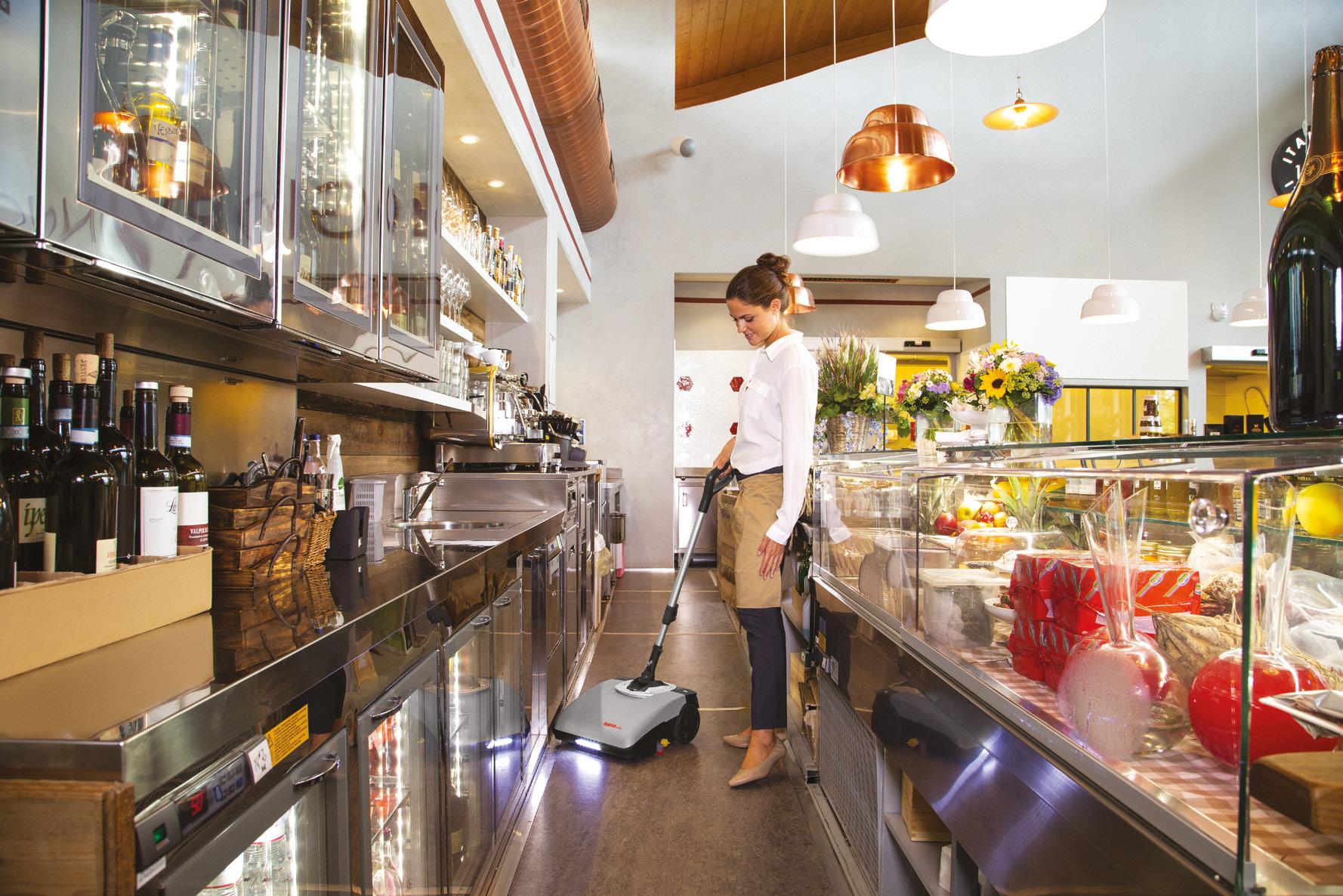
COMAC S.p.A. Via Maestri del Lavoro, 13 - 37059 Santa Maria di Zevio - Verona - ITALY Tel. 045 8774222 - www.comac.it - com@comac.it Comac S.p.A. org. cert. ISO 9001:2015, ISO 14001:2015, ISO 45001:2018, SA 8000:2014
E-Spray is a sanitizing professional spray gun designed to distribute disinfectant solutions effectively and uniformly on surfaces.

Comac E-Spray is lightweight and genuinely comfortable because it’s powered by a lithium battery that allows several hours of hygienization, freely and anywhere, without worrying about the cable. The solution is sprayed in tiny, light droplets that can get to every point of the area concerned and settle effectively.

Igea is Comac’s most compact floor scrubber, designed to replace manual cleaning systems like mops and buckets. Igea is so called micro floor scrubber, thus suitable for maintenance cleaning of surfaces up to 300 sq.m. Its extremely compact dimensions make it perfect for working in small or highly cluttered spaces like restaurants, bars, kitchens and small businesses, ensuring professional mechanized cleaning also in these environments.


Vispa EVO is the compact, powerful scrubbing machine that’s up to tackling the most stubborn dirt. It’s ideal for the maintenance cleaning of small and medium-sized areas, even when cluttered. It’s the evolution of the compact Comac scrubbing machines, as it offers the many well-known characteristics of walk-behinds, combining agility, power, reliability and technological innovation in a unique example of pure user pleasure.

installation of entryway mats to reduce track-in, and rapid attention to events such as leaks and spills, resulted in mean ingful decreases in particulate and mi crobial contamination on surfaces and in air, as well as overall reduction of total volatile organic compounds (TVOCs). After seven months of improved cleaning practices and environmental monitoring, the data showed meaningful decreases in airborne dust mass (50%), airborne fun gi (61%), airborne bacteria (40%), carpet dust fungi (40%), and carpet dust bacte ria (84%), and endotoxin (72%) over the previous five months before attention to cleaning was implemented. Perhaps most importantly, the data revealed intricate information about the indoor ecosystem and how source management and cleaning together can stabilize microen vironments and help prevent pollutant buildups that can compromise human health and valuable materials. For exam ple, quantitative measurements of air borne dust mass and carpet dust mass showed an inverse relationship between the two, i.e. as carpet dust is disturbed and resuspended, dust levels in the carpet de crease and airborne dust levels increase.
Conversely, as airborne dust settles onto carpet, total airborne dust mass decreas es and carpet dust mass increases36. And airborne biopollutant monitoring showed occasional spikes of Penicillium, Aspergil lus, and gram-negative and actinomycete bacteria, thus demonstrating that the in door environment is indeed an ecosys tem with normal fluctuations, yet with attention to source management through routine cleaning and immediate attention to unexpected occurrences, those fluctua tions can be controlled20
Current threats of pandemic respiratory disease and bioterror incidents bring a focus of concern to the need for effective cleaning and decontamination protocols addressing public transport vehicles (e.g. airplanes, trains, buses, subways, cruise ships, etc.). In those situations, the decon tamination approach must again place an emphasis on the physical removal of the pollutants, which in itself is a sanitization process. This can involve the use of HEPA vacuuming in combination with a practi cal wet cleaning/sanitizing method that ef fectively reduces the pathogen burden to a level below an infective threshold, while minimizing the introduction of chemical
1. Mitty, E (2009). “Infection control practices in assisted living communities”; Geriatric Nursing (London), 30(6):417–423.
2. Berry, MA (2018). “Cleaning professionalism and competent management”; Cleaning Science Quarterly 1(1):8–12.
3. Mendell, MJ Heath, GA (2005). “Do indoor pollutants and thermal conditions in schools influence student performance? A critical review of the literature”; Indoor Air, 15:27–52.
4. Dybendal, T., Wedberg, W.C., & Elsayed, S (1991). “Dust from carpeted and smooth floors. IV. Solid material, proteins and allergens collected in the different filter stages of vacuum cleaners after 10 days of use in schools”; Allergy, 46(6):427–435.
5. Sarpong, SB, Wood, RA, Karrison, T, & Eggleston, PA (1997). “Cockroach allergen (Bla g 1) in school dust”; Journal of Allergy and Clinical Immunology, 99(4):486–492.
6. Smedje, G, and Norback, D. (2001). “Irritants and allergens at school in relation to furnishings and cleaning”; Indoor Air, 11(2):127–133.
7. Abramson, SL, Turner-Henson, A, Anderson, L, Hemstreet, MP, Tang, S, Bartholomew, LK, Joseph, CLM, Tyrrell, S, Clark, NM, & Ownby, D (2006). “Allergens in school settings: Results of environmental assessments in 3 city school systems”; Journal of
pollutants into the environment being ad dressed. This type of approach presents a practical and feasible alternative to the massive use of chemical germicide sprays and gases which can present a major haz ard to remediators and occupants, as well as valuable finishing and furnishing mate rials37.
CONCLUSION
The indoor environment is recognized as a delicate yet complex ecosystem wherein contaminant reservoirs can easily become pollutant sources through the lack of an effective and frequent reduction and re moval process called cleaning. In order to maintain an ecological balance and pro mote the health of the indoor environ ment and its occupants, effective cleaning practices for both the prevention and re mediation of biological, chemical, and particulate pollution in special indoor en vironments must be identified and evalu ated and then implemented on a routine basis. And the only successful approach toward the accomplishment of this goal is through a dedicated and sustainable co operative industry effort in the area of cleaning science research.
School Health, 76(6):246–249.
8. Walinder, R, Norback, D, Wieslander, G, Smedje, G, Erwall, C, & Venge, P (1999). ”Nasal patency and lavage biomarkers in relation to settled dust and cleaning routines in schools”; Scandinavian Journal of Work, Environment, & Health, 25(2):137–143.
9. Higashiyama, M, Ito, T, Han, X, , PhD, Nishiyama, J, Tanno, A, Wada, T, Funaoka, MT, Yoshida, Y, Mikita, K, Ogawa, T, Okusa, Y, Kaku, K, Hatada, J, Hiramatsu, K, & Kawana, A (2011). “Trial to control an outbreak of Panton-Valentine leukocidin–positive methicillin-resistant Staphylococcus aureus at a boarding school in Japan”; American; Journal of Infection Control, 39:858 – 865.
10. Hostetler, K, Lux, M, Shelley, K, Drummond, J, & Laguna, P (2011). “MRSA as a health concern in athletic facilities”; Journal of Environmental Health, 74:18–25.
11. Zhang, X, Zhao, Z, Nordquist, T, Larsson, L, Sebastian, A, & Norback, D (2011). “A longitudinal study of sick building syndrome among pupils in relation to microbial components in dust in schools in China”; Science of the Total Environment, 409:5253–5259.
Full bibliography is available on the online version at dimensionepulito.it
22 RESEARCH OCTOBER 2022
FALPI TROLLEYS






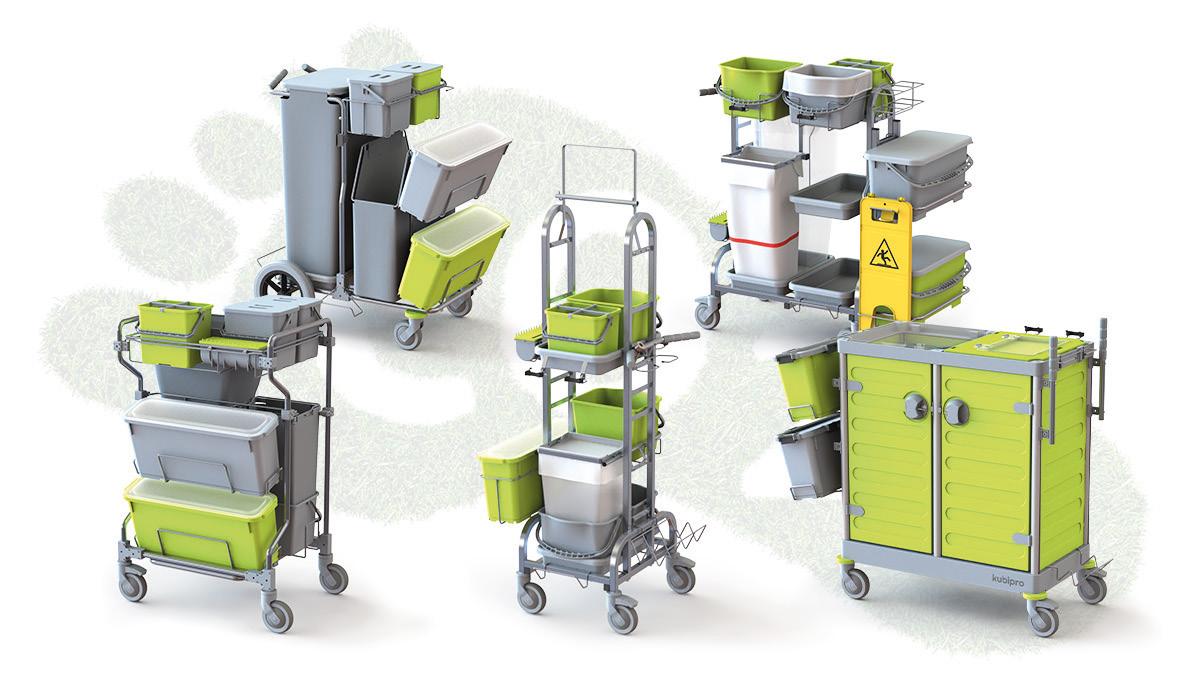
DO SOMETHING GREEN EVERY DAY...
CERTIFIED CFP ISO 14067:2018
Renewable energies A shift for a better future
In the face of an emergency that is having serious repercussions on families and businesses, urgent interventions are needed. Interventions that the EU, so far, has not been able to implement. But looking to the future, the only way to go is that of sustainability, which must not be abandoned
Maurizio Pedrini
24 OCTOBER 2022 ECONOMY
Companies, families and the entire economy appear to be in great difficulty, pierced and vilified by the overwhelming surge in the energy bill, in particular by the ex ponential increase in the cost of gas. In the "very hot" summer that we left behind - unfortunately shocked by temperatures never recorded before, drought and war - this incredible in crease immediately spilled over, with devastating consequences, on the val ue of the Single National Price, or the expenditure necessary to support the cost of wholesale electricity, which has grown exponentially during these hec tic months, by almost 400% (from 61 to 288 €/MWh in monthly average val ues). In short, a sort of "perfect storm" has hit Europe and Italy, which has led to unprecedented, truly unimag inable increases in electricity and gas bills. The increase in the price of nat ural gas is due not only to the tragic war in Ukraine, which has shocked the heart of our continent and the whole world, or to other important econom ic factors, but above all to speculative factors. Natural gas is a fungible com modity, the same regardless of the pro ducer, traded on the main world stock exchanges. In this delicate period, for example, we learned about the TTF (Title Transfer Facility), a virtual mar ket for natural gas trading based in the Netherlands, one of the main reference markets for gas trading in Europe. Af ter an early 2022 in which light was beginning to glimpse at the end of the tunnel, the outbreak of the dramatic war in Ukraine further aggravated the situation by bringing out the depend ence of Europe, and of Italy in particu lar, on Russian gas.
THE NEW HISTORICAL RECORD IN THE PRICE OF GAS
In March of this year, the new histor ic gas price record was reached, which exceeded 225 euro/MWh in terms of the TTF (Dutch benchmark index), 10 times the average price of previous

years. The increase in the reference price of natural gas has also dragged with it the wholesale prices of elec tricity. This is due to the fact that, in Italy, a large part of electricity pro duction (about 40%) still takes place through the gas used in the turbogas plants. Even for the Single National Price- as we said - the increases were dramatic, with an average price going from 60 euros/MWh between 2004 and 2020 to 120 euros/MWh in 2021 and almost 250 euros/MWh for the first six months of 2022. If, for exam ple, we compare the monthly average gas price for the month of August 2021 with that of the same month in 2022, we note that it has almost quintupled. This means that the gas and electricity bill then reached an absurd and unsus tainable weight for the pockets of fam ilies and businesses. In recent weeks, even if the price of gas has dropped slightly, the tragic dilemma has ma terialized for many Italians: to pay the bill or support myself? For many companies, especially small and medi um-sized companies and, in particular for the so-called "energy-intensive" ones that require high volumes of gas and electricity in a continuous cycle for the production of consumer goods, closure was feared.
The alarmed appeals of the categories and production chains have followed one another at an increasingly press ing pace: the now evident and merci less escalation of production costs, due to the diabolical mix between the increase - and the difficulty of finding - the costs of raw materials and energy appears almost unstoppable. The phe nomenon not only involves real risks for the very survival of businesses, but is also affecting primary, intermediate and final distribution companies. The chain is getting shorter and shorter: the explosion of increases in the cost of essential raw materials, such as milk and flour - for example - risks making primary and consumer goods such as bread and pasta unattainable for many Italians. The price of these products cannot be dumped to the detriment of consumers, with increases that would be truly unsustainable. In this context, so complex, delicate and anxious, with the threat of increasingly expensive and priceless autumn bills, the protesteven exasperated - has made its way on the one hand with the bonfires of bills burned in the street by increasingly ex asperated citizens, on the other hand the request - more and more pressing - by public opinion, to Italian and Eu ropean politics and institutions to find
25OCTOBER 2022
solutions that avoid an ever closer and more probable collapse. Unfortunate ly, however, the centering of the square immediately appeared distant, in some ways remote. The outgoing Italian gov ernment, led by Mario Draghi, has is sued three decrees in support of the poorest families and businesses, but the "bonus" policy does not seem to have given the desired results, appear ing - to most - as a sort of "buffer", or rather a real palliative. The problem, in essence, was not tackled with due determination, despite the roads, even those pursued by other countries close to us, not only geographically, were still practicable: no serious taxation of the extra profits of energy companies, not even ENI, whose 30% of the shares are owned by the state; the hypothesis of a serious tax exemption on bills, or a substantial budget variance to sup port families and businesses, in place of the disbursement of disheartening bonuses, has also disappeared. All this while within the EU, on the hypothe sis of placing a sort of "insurmounta ble threshold" on the price of gas, the brawl between those for and against it was unleashed, giving a clear signal of weakness both to Putin's Russia, which has unfortunately become an enemy not only of Ukraine, but of Brussels and the NATO countries, but also in the eyes of all citizens who still believe in the Europe of the people.
EU: THE PRICE CAP HAS REVEALED THE CONTRADICTIONS
Among the hypotheses on the table, therefore, the most popular one imme diately appeared that of the so-called "Price cap", conceived with two differ ent options to introduce a cap on the price of gas imported from Russia via pipe: setting an upper limit (which would be prefigured as a new sanction against Moscow), or set up a single Eu ropean entity to buy gas at a certain price, which should not fall below 35 euros per megawatt hour. The idea of
creating a "red zone" for the countries most exposed to cuts in Russian sup plies, including Italy, where a tempo rary administered price for gas linked to the trend of the TTF. Proposals that immediately caused contradictions and selfishness to explode between gas-producing countries, such as Nor way and states dependent up to their necks on Russian gas: just think that Germany imports about half of its gas from Russia, while France only gets a quarter of its own supply from Putin's country. Our "Teutonic" allies were not, however, sitting on their hands: the government led by the Social Dem ocratic Chancellor Olaf Scholz, to the general surprise of the European part ners, has allocated an impressive figure of 200 billion euros to face the emer gency. Italy, on the other hand, arrived - as too often happens - completely unprepared for the appointment with history. In the last twenty years, the energy problem has been complete ly set aside, ignored by governments: the path of progressive dependence on the import of gas from other states has been chosen, even at the cost of re nouncing to extract it where it is pres ent in its subsoil or in the sea, in this latter case by dismantling the drilling and platforms present in the Adriatic Sea, to allow neighboring Croatia to exploit undisturbed those methane deposits that are also Italian property. As for gas supplies in Italy, the picture appears merciless. According to data processed by Today, 72.7 billion cubic meters of gas were imported in 2021, of which 40% came from Russia, 29% from Algeria, 10% from Azerbaijan, 4% from Libya and 3% from Northern Eu rope. 13.5% came from LNG (liquefied natural gas). The Draghi government, after the Russian invasion of Ukraine, the sanctions imposed on Russia and the decision to stop the channel with the aggressor country, which triggered this bloody conflict, has taken steps to forge alliances with other supplier states, thinking about the purchase of
regasification vessels. Minister Cin golani has repeatedly reassured the Italians about the system's stability, perhaps with the small measures and sacrifices outlined in the energy saving plan, but witnessing the enormous dif ficulties of bringing the OLT Offshore regasification terminal to the port of Livorno LNG Toscana, consisting of a LNG carrier, the Golar Tundra, suitably modified and permanently anchored to the seabed of the city's port, there is certainly no reason to be happy. The most sobering fact in this regard is that other European cities, such as Barce lona, have had it without problems for years. Perhaps few know, in fact, that even Barcelona has a regasification plant, one of the largest in Europe, lo cated right in the port. The plant has existed since 1969, no one complains and is so integrated into the city system that residents hardly even realize its presence. In Italy, however, any choice of energy policy represents a problem: 35 years ago, as we all know, shocked by the Chernobyl tragedy, people said no to the use of atomic energy for civil purposes with the historic referendum on the issue. A moratorium was first decided, pending developments, then in 2011, a new referendum, this time against the government's idea of dust ing off nuclear power, with a new mor atorium, after the Fukushima Daiichi nuclear accident in Japan. Meanwhile, paradoxically, while the power plants of Caorso, in the province of Piacen za, Trino Vercellese and others under construction in 1986 were gradually left to rot before being definitively dis mantled, grew the dependence of our country on atomic energy, converted in electricity, which came to us and is still sold to us at a high price by the French, Swiss and Slovenian nuclear power plants which arose on our bor ders. Italy, the only country in Europe that does not have its own power plants of this type, imports about 10% of the electricity needed to run the produc tion of our companies and the lives of
26 ECONOMY OCTOBER 2022
families from its neighbors. Paradoxes, on which it would be worth reflecting, such as those of the development of re newable sources, an obligatory road in many ways, but still - unfortunatelyonly partially practiced in Italy, which should instead be supported with the utmost conviction, making the most of the opportunities offered from the PNRR. Just think of all the difficulties that arise from municipalities when considering the installation of a wind turbine system in a specific munic ipal area: a sort of revolution for the problems arising from environmental impact and pollution. Even photovol taics, which even a few years ago had seen Italy among the leading countries, certainly does not sail in good waters, with a clear reversal of the trend. Not
to mention the inconsistencies of the non-polluting solution hypothesized with the massive introduction of elec tricity, also envisaged by the 4.0 sus tainability plan which provides for the energy transition with the PNRR. The questions arise spontaneously: how is electricity produced? By burning fu els or using elements such as water, sun and wind. These, in fact, are the primary sources of energy, respective ly called fossil sources and renewable sources. But really, in our country, in a few years we will be able to replace the traditional fossil sources and the waste of an increasingly precious commodity such as water, now ter ribly wasted and precious in times of drought, with clean energy produced by the sun and from the wind, without

a great collective effort and everyone's commitment? Are not the requests of those who strongly ask for green and clean hydrogen, thanks to the contri bution of renewable energy, to enter fully into the stage of our future? It is necessary to invest, even on the part of companies, to be able to produce inde pendently, with photovoltaic systems or other renewable sources, the energy necessary to keep production going.
A PROBLEM THAT NEEDS AN IMMEDIATE SOLUTION
But in the face of this medium-term future, let us return to the imminence of a problem of strict survival, such as that of expensive energy, so urgent that it must find radical and immediate an swers. To solve the problem of the pro
27OCTOBER 2022
found energy crisis and the expensive bills, after the extraordinary EU Coun cil on energy saving, on the ceiling on the revenues of the infra-marginal companies but still with nothing done on the agreement on the cap on the price of gas, the new Italian govern ment has only one path to follow: that of supreme defense of the interests of its citizens, as the other EU states are doing, in spite of solemn declara tions. In order for the Italian system to survive, substantial investments of resources are required, which cannot be limited to a few tens of billions, dis tributed with the usual bonuses. Just to understand, we need a moratorium for families and businesses on unpaid bills, as well as the elimination (not the simple reduction) of excise duties relating to fuels, the enlargement of the umbrella of the guarantee on small businesses of energy suppliers that risk the crash if companies are insolvent. And, finally, how can we fail to envis age a serious and consistent taxation of the extra profits from energy com panies, unscrupulously earned to the detriment of consumers? Companies that so far, have paid nothing to the state coffers. It is not just a question linked to the economic emergency, but a real question of social justice. Not to mention that if these provisions were to result in a significant reduction in energy prices, this would be positive as it would likely imply less pressure on customers and a downward credit risk on energy sales. In short, we would be faced with choices that could benefit everyone, avoiding the risk of failure and collapse that hangs over our heads.
FIRST GOAL: FREE OURSELVES FROM THE DEPENDENCE ON RUSSIAN GAS
As with other fossil fuels (oil and coal), Italy has a strong dependence on for eign countries for gas as well. National production covers just 4% of the total gas requirement, while the remaining 96% (approximately 76 billion m3 of gas
in 2021) comes from foreign imports. The high dependence on foreign coun tries does not depend on the levels of exploitation of national resources: the gas reserves present in the Italian sub soil are limited and, even if we imagine overnight to be able to fully exploit them, we could cover our needs for gas only for a limited period of time - we are talking about a few years, if not even a few months - before they are exhausted forever. Our dependence on gas from abroad is concentrated in just five countries. The first, as is now known even to non-experts, is Russia, on which we depend for 40% of our needs. The second is Algeria, which satisfies 31% of our needs. Historically these two countries are the main sup pliers of gas in Italy, with Russia having acquired the primacy in particular in the last decade (as many analysts have pointed out, precisely in conjunction with the occupation of Crimea): com pared to the beginning of the millen nium, in fact, we have increased the flow of gas from Russia by 38%, while we have reduced that from Algeria by 20%. With the entry into operation of TAP (the Trans-Adriatic Pipeline that reaches Puglia from the Caspian Sea), in 2021 a new player in gas imports in Italy and Europe entered the scene: Azerbaijan, which today is our third country for gas imports, with 10%. Fi nally, there are Qatar and Libya, from which we import 9% and 4% of our needs respectively. In recent months, the Draghi government has acted con siderably at the international level to increase the import of gas from some of our supplier countries to reduce de pendence on Russia, thinking that this will make our energy system safer. But the five countries from which we im port 90% of our national gas needs, in addition to having abundant availabil ity of this fossil fuel, are all character ized by the presence of regimes classi fied as authoritarian. To build a safer (and more sustainable) energy system we cannot continue to focus on gas by
diversifying sources, but we must cut our needs from this fossil source as soon as possible and as much as pos sible and accelerate the energy transi tion to the maximum.
A SHIFT TO RENEWABLE SOURCES
Among the interventions to be imple mented: it seems essential that by March 2023 the Meloni-led govern ment undertakes to authorize the con struction of renewable energy plants for 90 GW of new installed power to be built within five years, to update the almost ignored Integrated National Plan for Energy and Climate 2030 (PNIEC), which represents the main tool for changing the energy and envi ronmental policy of our country to wards decarbonisation, with a goal of 100% electricity from renewable sources to be achieved by 2035; in ad dition, a cap must be imposed imme diately on the profits of companies that extract and transport fossil gas or oil. A decree that unlocks renewables must be developed and approved to re place the gas plants built after the 2003 national blackout and to reduce con sumption by 36 billion cubic meters by 2026. In essence, the outbreak of the catastrophic war in Ukraine and the growing concern of many people about the increase in bills, requires accelerat ing the energy transition of our coun try, as the only solution to get out of dependence on gas, starting with that of Russia. Much interest has been raised by the proposal made by some well-known environmental associa tions which have indicated possible ways to follow in order to deal with the dependence on foreign countries for the supply of gas in a structural way. These are regulatory and authorization measures to be implemented in the coming months which, if implemented at least in part, would make it possible to reduce gas consumption by 36 bil lion cubic meters per year by the end of 2026. How? By developing offshore
28 ECONOMY OCTOBER 2022
and onshore wind power, photovolta ics on roofs, even in historic centers, and on compromised areas (landfills, quarries, etc.), modern agrovoltaics that guarantees the integration of agri cultural production with energy, the production of biomethane (developed in a clear context of reducing the total number of animals raised and without subtracting land for food production), accumulation, pumping and moderni zation of networks. In particular, the associations first of all ask to author ize, by March 2023, new renewable en ergy plants for 90 GW of new installed capacity, equal to half of the 180 GW awaiting authorization, to be built by the end of 2026; update the National Integrated Energy and Climate Plan by June 2022, evaluating the goal of pro ducing 100% electricity from renewa ble sources by 2035; immediately set a ceiling on the profits of companies that extract and transport fossil gas or oil; activate as soon as possible the public debate on renewable energy plants above 10 MW of installed pow
er; develop the production of biometh ane from Organic Fraction of Urban Solid Waste, agricultural waste, live stock waste and purification sludge. And then to exclude by April 2022 the landscape authorization for integrated photovoltaics on the roofs of uncon strained buildings in historic centers; review building bonuses. Finally, an ticipate the elimination of the use of gas boilers in new buildings; set up a guarantee fund for the constitution of energy communities; activate a strate gy for efficiency and innovation in pro duction cycles and on sustainable mo bility. For months now, the energy problem has been at the center of the political debate, also thanks to an in cessant media campaign on the sub ject of very strong increases in the bill and unacceptable speculative dynam ics, first fueled by the increase in the purchase prices of fossil gas on the in ternational markets brought into play by the oligopolies of fossil fuels, fol lowing the restart of the world econo my after the first waves of Covid-19,
and then by the international tensions that resulted in the terrible war trig gered by the Russian invasion of Ukraine. A final consideration in the face of the devastating emergency we are experiencing, a step back from the path started with the PNRR and the energy transition would be very nega tive: thinking of reactivating coal or fuel oil thermoelectric power plants is an irrelevant option: even if they start again 1,000 MW of installed power, in addition to those already in operation, with these two fossil fuels, for example for 5 thousand hours/year, 5 TWh could be produced per year which in fact would save only 1 billion cubic me ters of fossil gas per year. Virtually nothing compared to the structural and respectful contribution of climate objectives and the fight against atmos pheric pollution that would guarantee the convinced development of renewa ble sources, energy efficiency, the pumping and storage system and the transmission and distribution net work.

29OCTOBER 2022
4CLEANPRO, facing new challenges
Since the beginning of the year, in full post covid restart, we have again been faced with another challenge: crisis of components linked to the production of raw materials that does not seem to sat isfy the volumes necessary for the global production of finished products and in or der not to miss anything, an energy crisis where today this item of expenditure ded icated to production has now become unsustainable. These last years will be re membered as the end of the era of global business where the free market existed on all continents without many constraints and where ex ports were so common that today it seems impossible to
give up certain markets.
The repercussion of this whole situation on the per formance of our production companies requires us to have to adapt our commer cial policies almost daily. Today we are no longer able to keep costs under con trol and therefore unable to foresee or establish pro grams and maintain invest ment plans without carefully weighing the consequences of an uncertain future.
The importance of maintain ing the quality standard at the expense of rising costs, however, puts us in front of a limit beyond which it be comes difficult to think of re sisting for a long time.
We are, like everyone else,
thinking of innovating, in vesting in research and developing in creasingly techno logical, eco-sus tainable products, certification and guarantee both on the protection of workers and on the product with an or ganizational impact of our companies which in the end involves in creasingly burdensome costs where then in the end it always makes us think that if you were real you might have been better off when you thought you were going to feel bad. In spite of everything, we are still enjoying good success with our products and the good customer loyalty still allows us to maintain a pos itive trend.
The quality of our compo nents remains our motive and despite the difficulties in finding the components, MADE IN ITALY prevails to day more than ever.
For the end of the year 2022, we will also present the new version of our flagship mod el: the Mira 40, the result of an important restyling while maintaining the main com ponents of the current ver sion.
Indeed, after years of great success, we have put togeth
er all the suggestions coming from our most loyal customers by making a clear division on what was good and what could be im proved. Thus, was born a very fascinat ing and even more re liable version as far as possible. We are proud of the result obtained and we are convinced that it will be a major player on the market in the coming years. The solutions made on this new model are also part of the new line of prod ucts that 4cleanpro is about to create and which will also be presented at the next in ternational event ISSA Pulire Show 2023, to be held at Fi era Milano from 9 to 11 May 2023.
These next months will be fundamental and I am sure that we will be able to con solidate our range of floor cleaning machines on the in ternational markets.

This is a bit of our note of hope and I sincerely hope that the world economic sit uation does not mean that the conflict on the doorstep of our Europe will be re solved as soon as possible.

sponsored content
www.4cleanpro.com
4CleanPro

Green economy a challenge for industry and society
Maurizio Pedrini
Thirteen years have passed since June 2009, when ministers from thirty-four countries solemnly signed the Green Growth Declaration, in which they declared their commit ment to: "Strengthen efforts to formu late new green growth strategies in the context of government responses to cri sis and beyond, recognizing that 'green' and 'growth' can go hand in hand”. At the same time, the granting of a man date to the OECD was approved for the development of a Green Growth Strat egy that took into account the various economic, environmental, social, tech nological and development aspects. Since that solemn commitment a lot has happened and, above all, for the world economy, the business world, the whole society, too many things - unfor tunately - have changed for the worse.
The indicators of objective involution are too many and very painful. It is al most useless to recall the devastating effects of the SARS-CoV 2 pandemic, which - according to the latest studies - has caused the GDP of the main indus trialized countries to regress by almost 5%. From the threatening and powerful appearance of the SARS-CoV-2 virus, it has been a succession of phenomena, largely unpredictable by the analysts themselves, which have also heavily affected the European economy, put ting our productive and social system in crisis: difficulties for companies in finding raw materials, war in Ukraine, sanctions against Russia, crazy surge in energy costs, with the price of gas and electricity skyrocketing, excessive in flation that is unfortunately leading our country to the recession. It is useless to
hide how, in the last two years, despite the launch by the Italian Government of the PNRR and the formal and finan cial obligation assumed, also through the Recovery Fund towards the Green turnaround, with the assumption of precise responsibilities of Italy towards of the EU itself, the enthusiastic fervor towards the green economy has not a little weakened. Obviously, this does not mean that the need for businesses to make ends meet and tighten their belts, as expected in view of next win ter, is in some way to mean the renunci ation and the breaking of commitments and the prospect of the "turning point" linked to environmental sustainability. If anything, this path has become even more mandatory and urgent: how can we pretend to ignore or prevaricate in the face of the devastating impact of cli
32 ENVIRONMENT OCTOBER 2022
Changing current growth patterns, consumer habits, technology and infrastructure is a long-term project and for some time we will find ourselves living with the consequences of the choices made in the past. Decisions for sustainable development will therefore have to be flexible enough, so as to be able to make full use of new technologies and seize unprecedented opportunities
mate change that is falling - inclementon us, with devastation, very high sum mer temperatures, drought and terrible floods? After all, in Europe, the path to sustainability has been taken for some time: Italy is an example that testifies that: the legislative provisions aimed at sustainability, CO2 reduction, pollution reduction also in the professional clean ing and public administration sector.
We refer, for example, to the legislation dictated by the new Minimum Environ mental Criteria for GPP in cleaning and hospitals, as well as the production, in spired by the Ecolabel Certification, of detergents and cleaning systems in the chemical sector, but also the techno logical leap made by years in the design and construction of cleaning machines.

In a nutshell, cleaning companies and not only have for years been increas
ingly attentive to energy and water saving and also to a production chain inspired by the maximum limitation of consumption and, above all, by the correct waste disposal cycle. The most far-sighted industries that, committed to practicing sustainability concretelynot only in words, but in deeds - have long since equipped their production sites with photovoltaic systems are a clear proof of this. A decidedly winning ecological choice, especially in light of the unprecedented peaks reached in recent months by the energy bill. Be ing “sustainable” and green, after all, is worthwhile in all senses, because in this way business processes are in creased and improved, resources are in vested more rationally. But if this were not enough, it is good to add that being a sustainable company considerably in
creases its brand reputation in the eyes of stakeholders. It is useless to hide, however, that precisely in the light of the facts, vicissitudes and uncertainties that have hit our industries and all of us, some questions arise spontaneously.
For many, the Green is just a "fashion", a noble declaration of intent, or does it represent a categorical and urgent commitment, or rather a challenge to be faced and overcome, getting to work immediately, if it has not yet been done?
Furthermore, what problems does this “green economy”, which is talked about so much, entail as a compulsory path, especially when considering the costs of businesses and families, as well as in terms of employment? These are ques tions of no small importance, even con sidering, as we said at the beginning, that the Green road - at least for the
33OCTOBER 2022
West - appears obligatory. At this point, another sore point, the basic question that we all ask ourselves arises: "All of this is valid only for the West"? As we put it with China, with other countries, other emerging economies, the socalled developing countries, in short, with those states that absorb, without any hesitation, most of the earth's ener gy resources, returning pollution, wast ing enormous goods and producing a disturbing mass of waste of all kinds? But, leaving aside the concerns, let's try to understand what the choice of Green consists of and what are its hoped for, possible consequences, for the benefit of the economy and of all of us.
REDEFINE GROWTH
The world economy, we said, is still plagued by numerous evils. While we may have emerged from the pandemic emergency, we are facing urgent issues such as the economic recession, the war in Ukraine, the terrible rise in energy costs, high unemployment, inflationary pressures and fiscal deficits. Precisely in the face of the countless difficulties of the present, however, it is necessary to look to the future to formulate new strategies, with the aim of ensuring that growth and progress, too hastily taken for granted, actually take place in the years to come. Retracing our steps, as we are doing in part as a result of the war and the sanctions imposed on Russia, would be not only wrong, but also imprudent. The risks would be very serious, and could cause terrible human costs, heavy obstacles to eco nomic growth and development. This could result, for example, in greater wa ter shortages, difficulties in the supply of resources, air and water pollution, climate change and irreversible loss of biodiversity. This is why, today more than ever, the Governments are urgent ly called to define precise strategies aimed at pursuing greener growth. If we really want that what good has been done with the 2021 Agenda and, above all, with the 2030 Agenda, which has
clearly defined 17 precise commitments aimed at environmental sustainability, will not be wasted, we must commit ourselves to finding and practicing new ways of production and consumption, redefining our own idea of progress and our criteria for measuring it. Entrepre neurs and citizens must be made truly protagonists of this ambitious journey, freeing the ground - through the knowl edge and practice of new lifestylesfrom prejudices and fears, sometimes irrational, of change itself. It is useless to hide, however, how difficult and tor tuous a path could be that requires all of us, in a few years, to change current growth models, consumer habits, pro duction technology, infrastructures, logistics and the distribution chain, just to mention some aspects of this real "Copernican Revolution". If some de cisions must be made in a short time, it is equally true that we are facing a long-term project, which is destined to project us into a new dimension. The keywords for companies linked to envi ronmental sustainability are innovation 4.0, digitalization and artificial intelli gence. Even the term "cleaning", in its broadest meaning, that is connected to the idea of a different collection of waste intended as an energy resource and source of economic wealth, as well as the term "recycling", are strictly con nected to our idea of Green Economy. Let's not forget that the modern econo my has been made possible by all-round innovation, not only by the purely tech nological one: we must try to imagine how the new business models, the new ways of working, the new urban and transport plans, are destined to play an extraordinarily important role in promoting green growth. This process must be pursued with a "Holy Alliance" between States, for the supreme good of the peoples and the Planet. Let's face it: no government alone has all the technological, scientific, financial and other resources necessary to pro mote green growth. The challenges are of a global nature and do not allow for
uncertainties or exceptions. “Green” and “growth” can and must go hand in hand. The OECD has been asked sever al times by many states to formulate a Green Growth Strategy. In recent years, both at the governmental level and at the work of civil society, proposals have been made on how countries can pursue economic growth and develop ment, while contrasting - at the same time - climate change and preventing costly environmental degradation, through inefficient use of natural re sources. The Towards Green Growth and Towards Green Growth - Monitor ing Progress: OECD Indicators publica tions undoubtedly constitute two cor nerstones of the valuable work carried out since 2009, as well as the famous, antecedent, Rio de Janeiro Conference, also known as the Hearth Summit, held in the great Brazilian metropolis from 3 to 14 June 1992, which was the first world meeting of the heads of state on the environment. It was an unprec edented event, also in terms of media impact and consequent political and development choices. At that time 172 governments and 108 heads of state or government participated, 2,400 repre sentatives of non-governmental organi zations, while over 17,000 people joined the NGO Forum. We know well howthese days - it is almost impossible to hope that all this will repeat itself.
SUSTAINABLE GROWTH STRATEGIES
Returning to the starting point, the OECD Green Growth Strategy propos es an operational framework of policies that is quite flexible, so that it can be adapted to different national circum stances and to various levels of devel opment. The OECD's Green Growth was designed to help achieve the Rio +20 goals, in collaboration with initi atives taken in other international fo rums, including UNEP, UNESCAP and the World Bank. The objectives are am bitious and include a political and oper ational agenda aimed at achieving con
34 ENVIRONMENT OCTOBER 2022
crete and measurable progress, capable of combining the needs of the economy with those of the environment. The central goal is to promote the condi tions necessary to foster innovation, investment and competition, capable of generating new sources of economic growth compatible with resilient eco systems. Furthermore, green growth strategies will have to take particular account of the numerous social and eq uity issues that can derive from a green er economy, on a local, national and global scale. Changing current growth models, consumer habits, technology and infrastructure - as we said - is a long-term project and for some time we will find ourselves living with the con sequences of the choices made in the past. Decisions for green growth will therefore have to be flexible enough, in order to make full use of new technolo gies and seize unprecedented opportu nities. This flexibility will also have to enable us to quickly abandon an initial
approach, where a better one is present ed. The use and efficient management of resources are an essential objective of economic policy, although many fiscal and regulatory interventions, not generally associated with a "green" agenda, will also play a primary role. Two types of intervention are essential in any green growth strategy: the first includes broadly applicable framework policies, capable of strengthening both economic growth and the conserva tion of natural capital. These are fiscal and regulatory instruments, such as tax and competition policy measures, which, if well designed and implement ed, allow for a more efficient allocation of resources. This is the usual agenda of economic policy, together with the awareness of also benefiting the envi ronment. It would also be desirable to include innovation policies within this type of intervention. The second in tervention includes policies capable of encouraging the efficient use of natural
resources and making pollution more expensive. These policies include a mix of market-based instruments, such as environmental taxes, regulations, tech nology support policies and voluntary approaches. Whatever the national context, the attribution of a price to the pollution or excessive exploitation of rare natural resources, through mech anisms such as taxes or systems of ne gotiable permits, should be a central element of the set of policies adopted. Price mechanisms tend to reduce the costs incurred to achieve a certain goal and provide incentives to further in crease efficiency and innovation. In our view, an increased and reasoned use of environmental taxes could play an important role in fiscal reforms geared towards economic growth, as it could help reduce the distortions introduced by both personal and corporate income taxes and social contributions. Taxes on energy products and carbon diox ide emissions could also form part of a

35OCTOBER 2022
broader fiscal consolidation package, of fering an interesting alternative to high er taxes on labor or corporate income or to cuts in public spending. However, not all situations lend themselves to being managed with market instru ments. In some cases, well-designed legislation, active technology support policies and voluntary approaches may prove more appropriate to complement such tools. Furthermore, in many situa tions, the responsiveness of businesses and consumers to the signals sent by pricing policy could be strengthened by information measures highlighting the consequences of environmental damage caused by specific activities, as well as the availability of cleaner alternatives. In essence, the econom ic policy decisions made today should be more forward-looking, since growth patterns and technological changes tend to use each other, thus creating a dependence on the path followed and on technological and institutional con straints. It should not be forgotten that environmental impacts are cumulative and sometimes irreversible. By acting today to avoid unfavorable, irreversi ble or even catastrophic outcomes, we could pay a lower price in economic terms tomorrow. In short, innovation is a fundamental factor for the benefit of green growth. Conversely, social and economic inertia can be so strong that even a change capable of producing significant benefits is unable to change behavior. Innovation plays a key role in making growth "green", breaking the dependence on conventional operating methods and helping to untie growth from the exhaustion of natural capital.
GREEN INNOVATION AND EMPLOYMENT
There are many challenges that a green innovation is called to face: green growth strategies have to face multiple challenges. Let's try to examine some of them: many environmental external ities are not taxed or are insufficiently taxed and could be misunderstood. For
example, a carbon dioxide tax could spur innovation aimed at tackling cli mate change, but current carbon di oxide prices are too low to provide adequate incentives. New technologies may not be able to compete with ex isting technologies, find their way into the market and grow, particularly in markets such as transport and energy, where existing technologies occupy a dominant position. In some cases, in vestment in relevant research and tem porary support for the development and commercialization of green tech nologies may prove necessary. This sup port should encourage the emergence and adoption of efficient technologies, minimizing the risks of technological constraints, the lack of competition or the exclusion of private investments. It is also important to plan to strength en the markets so that they are able to welcome green innovation, for example through well-designed public procure ment, requirements and regulations, as is happening in our country with the Minimum Environmental Criteria im plementing the GPP. Barriers to trade and investment can severely hinder the development and deployment of green technologies. By reducing them consid erably and ensuring effective protec tion of intellectual property rights, the development and diffusion of technol ogies can be encouraged and foreign direct investment and licensing can be facilitated. Looking to the future with confidence, multilateral action will also be needed to facilitate the access of least developed countries to green technol ogies. Ultimately, greener growth will create new jobs and will require spe cialized profiles in emerging environ mentally friendly businesses. However, some jobs will be at risk and, therefore, it will be necessary to provide for the relocation of workers from shrinking sectors and companies to expanding economic sectors and companies, such as those that replace polluting activities with cleaner alternatives or that provide environmental services. Moreover, it
should be emphasized that investments in green activities have the necessary prerequisites for creating new jobs. In vesting in green businesses will create numerous jobs and many governments have already highlighted the considera ble potential for job growth represented by some of their green incentive pack ages and broader growth strategies. Re cent estimates show, for example, that up to 20 million jobs could be created worldwide in the renewable energy gen eration and distribution sector by 2030. This is because, inevitably, renewa ble energies will grow considerably, at the expense of more polluting energy sources, and this will lead to a loss of jobs. However, it is likely that this loss will affect a small proportion of the to tal active population.
CONCLUSIONS
Green growth, if well managed, will be able to generate new sources of growth by investing in several aspects of eco nomic and social life, starting with pro ductivity. Incentives should be provid ed for greater efficiency in the use of resources and natural heritage through an increase in the same, a reduction in waste and energy consumption. Inno vation must be accompanied by policies and conditions that make it possible to create value and manage environmen tal issues in an innovative way. With new markets in mind, the demand for green technologies, products and ser vices will be encouraged. To create and sustain a widespread peaceful climate, it will be necessary to increase investor confidence through greater stability and predictability in the way govern ments manage key environmental is sues. Finally, stability, a fundamental factor that can only be achieved with more balanced macroeconomic condi tions, less volatile resource prices and support for fiscal consolidation through the review of the composition and effi ciency of public spending and the in crease in revenues through the alloca tion of a price to pollution.
36 ENVIRONMENT OCTOBER 2022
Fimap launches its most impressive and powerful scrubber dryer, the GMG
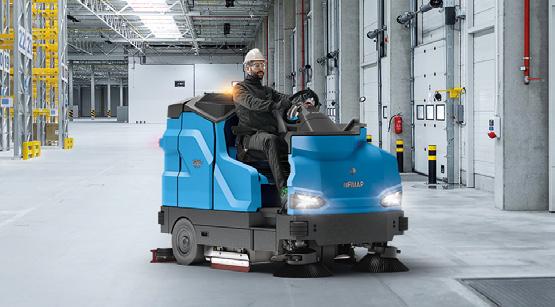
GMG has been created to offer a fast and powerful solution to halve cleaning times in large environments: industrial structures, ware houses, logistics centres, car parks, stations and airports. Given that the bigger the space, the more the time factor affects productivity, speed of cleaning was the first imperative: GMG scrubs and dries floors at 9 km/h, a record speed that no other machine can currently offer, which increases productivity by 30%.
The Cylindrical version rais es productivity even high er by being able to pick up small solid debris in addition to scrubbing and drying the floor, thus performing three cleaning tasks in one go. GMG can operate continu ously for 10 hours on a single charge of the lithium bat teries and clean ramps with gradients of up to 20% at
full load. Not even the type of dirt can hinder GMG, with the possibility of increasing the pressure on the brushes to 250 kg. In addition, GMG is the only scrubbing ma chine to have a suction sys tem on the side brush, which makes it effective not only along the edges but further extends the cleaning track, thereby increasing produc tivity. Despite its size, it is remarkably agile, thanks to the rear-wheel drive on two independent motors, which enables it to manoeuvre smoothly even in very tight spaces, as in the case of re versing, which it achieves with a single movement in just 2.5 m.
The machine comes with ac cessories such as the vacu um wand, which harnesses the power of the dual threestage suction motor to col lect dirt deposited in hidden corners, and the spray gun,
useful for rinsing tanks when there is no tap nearby. The Plus version's display is a real assistant throughout the operation. It suggests the correct parameters to the operator thanks to its 9 preset cleaning programs, and provides constant training through video tutorials onboard.
The widest possible range of safety equipment has been developed for GMG to pre vent any inconvenience, and protect the operator, the op erating environment and the machine itself. In addition to the anti-collision sensors and rear camera, the Blue Safety Spotlight can be in stalled, which projects a blue light that warns of GMG's presence, thus preventing accidents.
Today's technology offers the chance to approach a cleaning project in a new, more conscious way, through data collection, optimising cleaning and its management. With GMG, accuracy has reached a new level. The FFM - Fimap Fleet Management system col lects and transmits the infor mation to the My.Machine app. What's new is indoor tracking, which allows you to know within buildings which areas have already been cleaned and which still need
doing to complete the ser vice, providing an even more precise overview. Complet ing the picture is GMG's onboard computer, whose dis play shows the state of the batteries, reporting usage times, the sq.m cleaned and litres of water used, energy consumption and the re maining battery and tank ca pacity. Also, it offers an esti mate of how many resources could be saved by switching to the Eco Mode program, which favours a more sus tainable cleaning style when conditions allow.
Focus on environmental as pects has run through the entire GMG project. Com panies can monitor the CO2 produced both via the My.Machine app and the on board computer. There are technologies, dosing sys tems and cleaning programs to contain and make more responsible use of resourc es, and a recycling system that recovers and filters the cleaning solution to make it available again. Fimap thus puts tools in the hands of companies to revolutionise cleaning services with actions that increase efficiency and sustainability
www.fimap.com
MACHINES
Innovation made in Italy
Brushes and brooms are the primordial symbol of cleaning, products originally considered simple but now requiring a high degree of specializataion to meet specific cleaning needs and comply with the highest standards of hygiene. This is the background to IGEAX, the new innovative and international face of Ariston Cleaning Solutions, a leading brushware company for more than 80 years, which also includes ARICASA brand, known worldwide for its special range of uniquely designed and attractive household products.
IGEAX is the ideal partner for every cleaning need: solutions o ered include everything from the Hygiene and Detectable lines for the food sector to the Industrial line designed for cleaning in commercial activities, through the Aricasa line of products intended for GDS and domestic use. A wide variety of items made in Italy from high quality raw materials allow you to get the most out of any operation and any environment with the minimum e ort. Innovation characterizes the entire range of IGEAX products, designed to o er the market unique solutions such as the universal connection that expands
compatibility to all major thread types marketed worldwide, giving IGEAX partners a significant competitive advantage.











CERTIFIED QUALITY

The e ciency of internal processes, quality of production and attention to international regulations have led the company to obtain ISO:9001 certification and to become a member of FEIBP (European Federation of the Brush Industry), whose membership certifies that the products o ered comply with current hygiene regulations. IGEAX also pays close attention to regulations in order to be able to o er
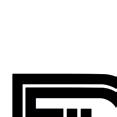
items that are safe and suitable for the food industry. Tools of the Hygiene and Detectable lines comply with EC Regulation 1935/2004 on materials and articles intended to come into contact with food, Regulation (EC) 2023/2006 on good manufacturing practices, and Regulation (EC) 10/2011 on plastic materials and articles. They also comply with Title 21 CFR of the US Food and
Drug Administration (FDA).
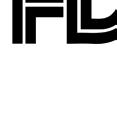
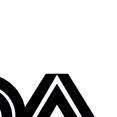
INNOVATION
The beginning of IGEAX was marked by innovation, clearly showing how the company’s mission is devoted to the development of e cient and safe tools that are designed according to the specific needs of the food industry. Today, IGEAX o ers a complete professional line to best support any



R
SUITABLE FOR FOOD CONTACT
FDA CERTIFICATION
HYGIENE LINE DETECTABLE LINE
One piece squeegees


One piece handle

manual cleaning operation. The projects undertaken during the year led to enriching the range with new products with high innovative content, foremost among them the one-piece plastic handle. Made with the latest technologies for the production and processing of plastic materials, it is extremely strong and handy, ergonomic and anti-slip. Less 60 percent deformation under pressure, 5 percent lighter, 32 mm constant diameter to reduce hand strain, made in 150 cm version to fit even
tall stature and 130 cm version to fit di erent tools, available in 5 colors and detectable version, detectable by magnets, metal-detector and X-ray: the one-piece handle has potential to become a key ally. The second project made cleaning of wet surfaces more e ective and facilitated the removal of all kinds of liquids by renovating the one-piece squeegee line. Larger sizes, stronger materials, and more secure attachment make them extremely e cient and e ective. The special range
is available in 5 colors and includes the manual squeegee with a 30 cm ergonomic grip for convenient cleaning of tables, counters and small surfaces.

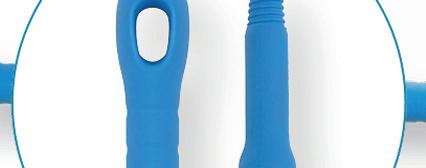
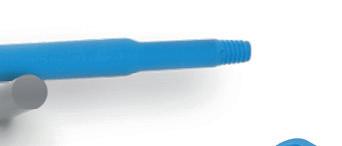
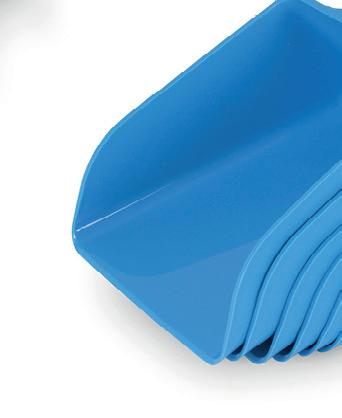

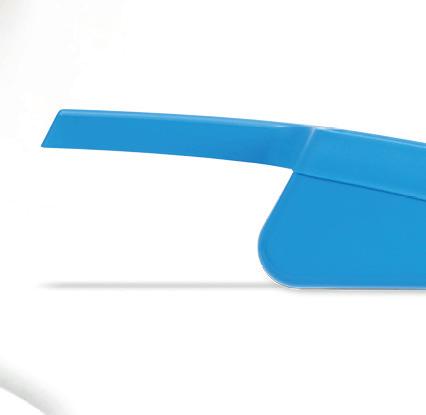
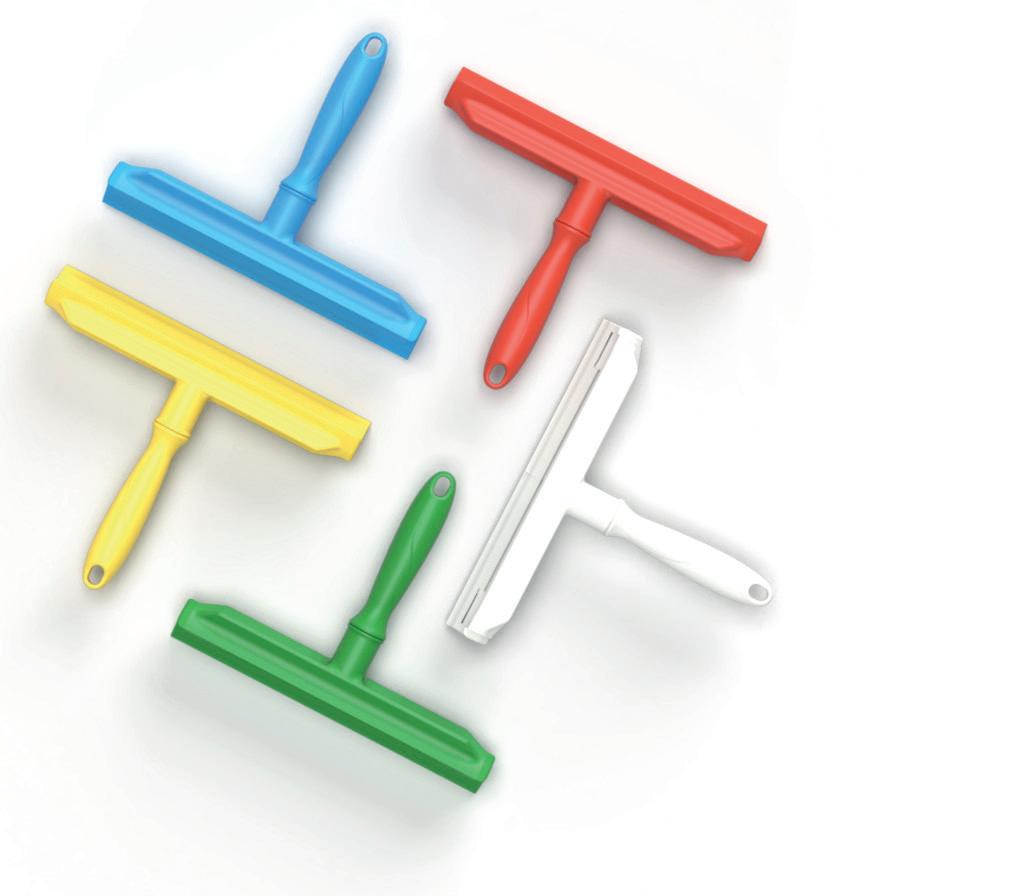

LOOKING INTO THE FUTURE
In 2023, IGEAX will be staying true to its mission: the range of items is constantly evolving, always reflecting new needs to which the company readily responds with tools that match the tasks required in the specific environments. A

particularly interesting innovation for the Food & Beverage sector will be available in the last quarter of 2022: new scoops with a one-piece structure, ergonomic grip, and high-grip profile promote hygiene and reduce operator e ort.

Strong and lightweight, they can be stacked reducing storage volume and are available in di erent sizes, 5 colors and in detectable version.
www.igeax.com





 One piece hand scoop
One piece hand scoop
SPONSORED CONTENT
The World Employment and Social Outlook

Strict, economy-wide workplace closures have been phased out in most countries. While new multiple global crises are unfolding, restrictive measures relating to COVID-19 are being lifted around the world. Workplace closures in their strictest forms (economy-wide required closures for all but essential workplaces) have been largely phased out. Only East Asia has recently seen an increase in the number of workers affected by strict measures
Cristina Cardinali
Positive trends in hours worked have stalled and risk being re versed. The number of hours worked in the world has deteriorat ed in the first quarter of 2022 and re mains 3.8 per cent below the level of the fourth quarter of 2019 (the pre-crisis benchmark), equivalent to a deficit of 112 million full-time jobs, indicating a significant setback in the recovery pro cess. Recent containment measures in China account for the bulk of the glob al decline. These estimates for the first quarter of 2022 present a marked deteri oration compared to the ILO’s previous projections of January 2022 (2.4 per cent below the pre-crisis level, equivalent to 70 million full-time jobs). The conflict in Ukraine has had not only a regional im pact but has also hit the global economy by increasing inflation, especially in food and energy prices, and disrupting global supply chains. In addition, heightened
40 OCTOBER 2022 LABOUR MARKET
financial turbulence and monetary pol icy tightening is likely to have a broader impact on labour markets around the world in the months to come. There is a growing but uncertain risk of a further deterioration in hours worked over 2022. Weekly hour estimates refer to hours worked of paid work and do not include unpaid domestic work or care for others. The gender gap in hours worked remains large, despite positive developments in high-income countries. The recovery is not closing the gender gap in hours worked in employment, which was al ready considerable prior to, and widened further, during the crisis. While some progress has been made in reducing the gap in high-income countries, women globally now spend 18.9 hours weekly in employment, or 57 percent of average hours worked by men (33.4 hours).
GREAT DIVERGENCES PERSIST
By the end of 2021, employment had returned to pre-crisis levels or even ex ceeded them in the majority of high-in come countries, while deficits persisted in most middle-income economies.
Overall, global labour income surpassed its pre-crisis level by 0.9 per cent in 2021, driven by high-income countries and China.
However, this general trend conceals considerable disparities. In 2021, three out of five workers lived in countries where labour incomes had not yet recov ered to their level prior to the crisis.
Informal women workers have been hit harder than their male counterparts. The number of informal jobs plunged by 20 per cent at the height of the crisis in the second quarter of 2020, twice the impact registered among workers in for mal employment. And within informal employment, women were hit harder than men. In the second quarter of 2020, the number of women in informal em ployment declined by 24 per cent relative to the pre-crisis situation, compared to a decrease of 18 per cent among men. The sectors in which women are typically engaged informally and their dispropor
tionate care responsibilities accounted for this highly unequal impact. By the last quarter of 2021, the recovery in in formal employment had overtaken that of formal employment, increasing the share of informal employment in total employment. Overall, the speed of em ployment recovery has been slower for women than for men, which has contrib uted to a growing gender employment gap globally.
INFLATION, WAGES AND EMPLOYMENT
Tightening of labour markets in some advanced economies but little sign of general overheating. The sharp increase in job vacancies in advanced economies at the end of 2021 and beginning of 2022 has led to a tightening of labour markets with a growing number of jobs available relative to jobseekers, with the latter re maining roughly stable. In 39 countries with available data (mainly advanced countries), labour market tightness in creased by an average of 32 per cent, with considerable differences between countries. Overall, there is no strong ev idence that labour markets are generally overheated, as the pool of unemployed and underutilized labour continues to be considerable in most of the coun tries analysed. Furthermore, developing economies continue to suffer significant labour market slack.
Increasing inflation poses a major chal lenge to maintaining the purchasing power of labour income. Global infla tion, mainly driven by increases in food and energy prices and supply disrup tions, adds further risks to the recovery and an erosion of real incomes for work ers and their families. In the absence of commensurate wage increases, ag gregate demand could fall significantly, thereby threatening economic growth and employment. Based on countries with available data, real wages grew in 2020–21 by 1.6 per cent in the median country, which is 0.7 percentage points below the median growth in 2019. De spite tighter labour markets, therefore,
the overall risk of a wage-price spiral currently remains low.
A HUMAN-CENTRED RECOVERY
The multiplication of crises, in addition to increasing inequalities between and within countries, hampers more than ever efforts to make labour markets more inclusive and resilient, putting recent re covery gains at risk. In this complex and uncertain situation, policymakers need to carefully navigate both the contin uing effects of the COVID-19 crisis and the actual and potential shocks of the Ukraine conflict, including the impact of inflation on jobs and real wages. Particu lar attention should be given to:
• Providing timely and effective sup port to maintain the purchasing power of labour income and the overall living standards of workers and their families.
• Carefully adjusting the macroeconom ic policy stance to address inflationary and debt sustainability pressures while recognizing the need to facilitate a jobrich and inclusive recovery.
• Ensuring that hard-hit groups and sec tors are protected through social pro tection for workers and support to en terprises, especially MSMEs and those operating in the informal economy.
• Over the longer term, supporting well-designed sectoral policies that promote the creation of decent jobs, matched by strong labour market insti tutions and social dialogue.
• Monitoring and assessing the impacts of multiple crises on the world of work, with a particular focus on addressing in equality, livelihoods and sustainability. Taken together, this requires a compre hensive approach and international co ordination as exemplified in the UN Sec retary-General’s initiative, the Global Accelerator for Jobs and Social Protec tion for Just Transitions, and as advocat ed by the ILO’s Call to Action for a Hu man-Centred Recovery adopted in June 2021.
(Source: ILO Monitor on the world of work. Ninth edition, 23 May 2022)
41OCTOBER 2022
Cleaning is at home at “Iginio Massari Alta Pasticceria”
Between delights of the palate and sweet suggestions, we were guests of the historic production plant in Brescia, where we talked about hygiene and sanitation with Nicola Massari, son of the great pastry chef, responsible for the production area and engaged in Research and Development
Maurizio Pedrini
Who doesn't know Iginio Massari? This extraordi nary pastry chef, probably the most famous on the planet, is a well-known television face, protago nist since 2017 of the Iginio Massari - The Sweetman program, where com petitors try their hand at creating their best dessert. During the preparation the chef corrects and follows them, judging them at the end of the test. A showman, in short, capable of suggest ing, with his undoubted charm, those who love the delights and pleasures of the throat. The entire professional itin erary of Iginio Massari was inspired by

the certainty that the use of raw mate rials of the highest quality, attention to detail, aesthetics and the balance be tween tradition and innovation were the keys to celebrate and elevate the culture of pastry at its highest expres sion. Today, a qualified team of expert pastry chefs shares with the “Maestro"
The “Maestro” Iginio Massari.
"Iginio Massari Alta Pasticceria" is a reference brand in Italian artisan pastry and it is recognized for the excellence of the products and the quality of the service
42 CASE HISTORY OCTOBER 2022
the vision and principles that are the basis of the success of the products of the Iginio Massari Alta Pasticceria brand, never static because in constant renewal and study, thanks to a prolif ic research and innovation led direct ly by the Massari family. We went to visit the historic Pasticceria Veneto in Brescia, where we met Nicola, son of the famous pastry chef. Entrepreneur and board member of "Iginio Massari Alta Pasticceria", our interlocutor is re sponsible for the production area and is engaged in Research and Develop ment together with his father and sis ter Debora.
How can we summarize in a few lines the history and the prestig
ious mission of “Iginio Massari Alta Pasticceria”?
“The first historic Pasticceria Veneto was founded in Brescia by my father and mother in 1971 and is recognized as one of the best in the world, winner of numerous awards and since 2010 at the top of the Gambero Rosso ranking. With the conviction that pastry repre sents above all an occasion for joy, dad with my sister Debora and myself cre ated "Iginio Massari Alta Pasticceria", a reference brand in Italian artisan pas try, recognized for the excellence of the products, quality of the service and with the mission of providing an op portunity for gratification and pleas ure through memorable experiences to share and tell. To date, the brand is
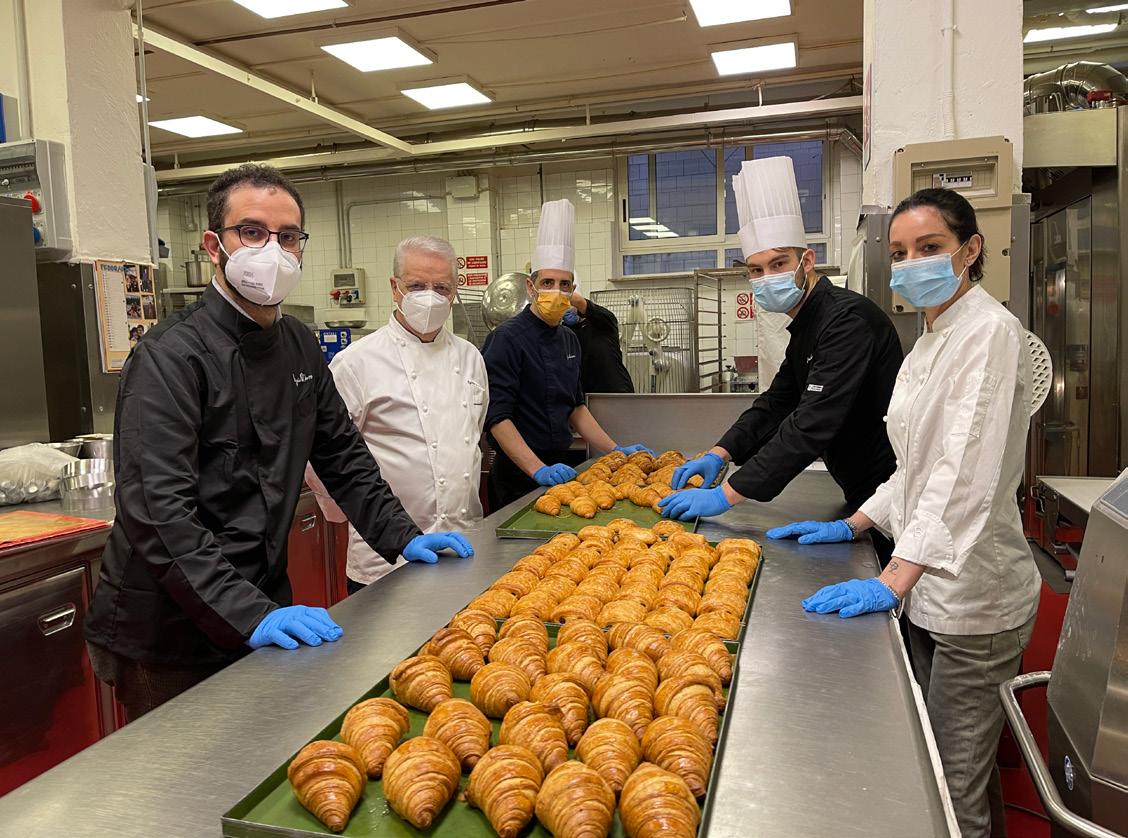
present on the national territory with five pastry shops and an extensive net work of Pop-Up Stores while it ships throughout Europe with the online shop IginioMassari.it”.
How did you experience the difficult period of the pandemic and what priorities did you set yourself?
“During the Covid 19 pandemic, keep ing all employees and workers healthy and safe was a very demanding factor for Iginio Massari Alta Pasticceria, as for all the confectionery and food industries, which certainly entailed significant organizational changes. In particular, we have equipped our selves with meters with thermal im aging cameras linked to the badge
43OCTOBER 2022
for the entire production, which was subsequently also connected to the green pass control processes. In our stores, however, this operation took place with a specific computerized procedure and with specially trained managers. We activated direct con trol procedures, using swabs, only if the case of a positive subject had oc curred in a workplace, in order to iso late asymptomatic or not yet asymp tomatic subjects as soon as possible. Apart from the initial uncertainties,
with a great sense of responsibility, in their timely application”.
Prevention of worker risks and safety have become categorical im peratives: concretely, how did you express these concepts in daily practice?
“We have provided our staff with an adequate supply of Ppe for Covid pre vention, with the obligation to wear Ffp2 masks right away, also focusing on social distancing and the revision
The problem of social distancing has undoubtedly represented for many companies one of the main obstacles to be faced: was this also the case for you?
“I would say no, fortunately, we only consolidated the previously adopted routine spacing, greater than two me ters. Rather, we have carried out some significant interventions, through posters and specific signs, to regulate the distancing of customers in our points of sale”.
Have you also adopted more strin gent hygiene and sanitizing meas ures for surfaces?
“We could not do otherwise, given the circumstances: we have operated with specific and frequent environmental sanitization and disinfection, inter vening twice a month, or in the case of a staff member’s positivity, with more weighty interventions”.
Who takes care of the cleaning in the production plant and what are the specific tasks?
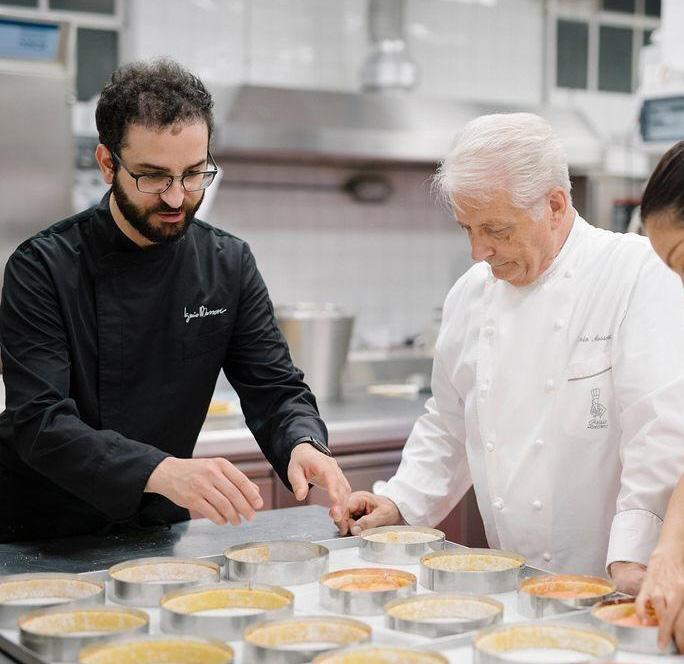
I would say that the balance of this delicate phase of our corporate life is positive: we have equipped ourselves with tools that, over time and to the test of facts, have proved to be very effective, allowing us to achieve the objectives we had set for ourselves. The employees not only welcomed the procedures established by the safety plans, but also actively collaborated,
of the sessions in the canteen. No ex traordinary new investments were necessary, because we have always made use of these devices, with ex treme thoughtfulness and attention to both prevention and maximum safety in the workplace. The only small, fur ther investment was that of swabs, to have further confirmation in terms of prevention”.
“For routine cleaning and mainte nance, we can count on a team of six specially trained employees who are dedicated exclusively to this del icate task. They are responsible for both cleaning the machines, with related production lines, and the in ternal surfaces of the confectionery factory. Instead, as regards the aer aulic ducts, which guarantee the ex change and healthiness of the air in indoor environments, we can count on the precious support of a mainte nance technician who, among other things, has great experience with the hydraulic and mechanical systems. Therefore, I can say that our indus try is currently able to ensure not only very high standards of surface hygiene and sanitation, but also op timal internal ventilation, given that - during these two years of pandemic - we have increased the primary air flow in all the premises”.
44 CASE HISTORY OCTOBER 2022
How did you work in the setting and definition phase of new and more rigorous procedures to be followed, not only in the sanitization and dis infection of surfaces, but also in im plementing the precise indications coming from the various PMDs?
“We have equipped ourselves with access control systems, strengthen ing the surface disinfection activities through the use of steam. In reality, however, it must be honestly said that, with respect to the indications that have been given to us, we have not had to invent anything new. In fact, our in terventions have always been punctual and tight, constantly providing the ut most care and attention in every sin gle phase. Above all, we implemented
cleaning and sanitizing in the chang ing rooms, in the dining room and in the bathrooms, because the other are as were already adequately cared for”.
Can you describe the various stages of action you have taken?
“In our handbook, in the first place, I would certainly put the actual clean ing activities, or those that concern the complex of procedures and oper ations aimed at removing dust, un wanted material or dirt from surfaces, objects, confined spaces and areas of relevance. Immediately after, the socalled disinfection activities, concern ing the complex of procedures and operations aimed at making certain confined environments and pertinent
areas healthy, by means of the de struction or inactivation of pathogenic microorganisms. Finally, sanitation, which for us has the primary purpose of providing safe, processed, prepared, marketed and sold food in perfectly
For routine cleaning and maintenance, we can count on a team of six specially trained employees who are dedicated exclusively to this delicate task

45OCTOBER 2022
clean environments, so as to prevent the contamination of harmful micro organisms and minimize their prolif eration”.
So, for you, does cleaning have a very extensive and decisive mean ing in production activities and in the life of the company itself?
“In a broad sense, certainly, even if it is, in fact, only part of the more com plex sanitation process, which aims to make the entire work environment hygienically safe, also intervening on the removal and destruction of main sources of contamination, such as pri marily pathogenic microorganisms. In fact, the sanitation of environments and surfaces in our production plant takes place through two phases: a first step of cleaning and cleansing and a second step of disinfection, in which pathogenic contaminants will be elim inated”.
How important is for you the use of cutting-edge technologies and prod ucts to achieve maximum hygiene of surfaces and production areas?
"Maximum, although training in the use of new chemicals is always re quired. In particular, we avoid those with high concentrations, because there is the risk that they are used inap propriately. As for the use of machines and technologies for mechanized sur face cleaning, we use both scrubbing machines and sweepers, preferably walk-behind and small-medium sized ones. In recent years, I can say that I
have personally noticed the effective ness of Rotowash machines, which focus their technology on two coun ter-rotating cylindrical brushes; in this case, the floor cleaning process takes place mainly through the mechanical action of the brushes which, with the help of fresh water and detergent, bind the dirt towards a central drum which in turn diverts it into a collection tank. We also make extensive use of some types of industrial vacuum cleaners, which have also proved to be very val uable over time. Finally, just during the pandemic, we bought some steam generators. We still lack, however, a hot water pressure washer; we will pro ceed soon to buy at least one”.
For routine cleaning of the various production areas and offices, you therefore rely on internal staff. Are you satisfied, or would you consider alternative solutions?
“We have thought several times of outsourcing the cleaning service, how ever - for now - it was decided to opt only for in-depth external cleaning, while routine remains in our hands.
The search for the cleaning company, in this case, is mainly carried out via the internet, after which we move on to direct presentation, to checking the certifications and, last but not least, to the analysis of the quality-price ratio of the offer that is made to us”.
How is the control on the effective ness of the interventions imple mented, also to guarantee the inter
nal staff and the production offered to your vast and loyal clientele?
“The internal quality control team is made up of three people, one of whom is full-time, who is also responsible for following all aspects and hygiene procedures. Checking the effective ness of cleaning and sanitizing in the various environments of our factory is a particularly important and deli cate process: it ranges from visual and tactile verification of sanitized surfac es, equipment and containers to the search for the presence of allergens through instruments or laboratory analyzes; as well as, again by means of specific instrumentation or laboratory analysis, of chemical residues, pH or maximum levels of disinfectants”.
Can we say that the Iginio Massari Alta Pasticceria company emerged strengthened, on a hygienic level, by the hard experience of the Covid 19 Pandemic?
“Well, even if we would have gladly done without this experience, I can say that Sars CoV 2 has made us all a little more aware of the extreme importance of cleaning. I noticed that the company staff is more attentive to thorough hand washing and drying. In general, this experience has strengthened in us the idea that the control of clean ing-sanitation procedures and the con stant updating of the same represent the only weapons at our disposal to ensure the maximum safety of the people who are close to us and work at our flank”.

46 OCTOBER 2022
MP-HT sweepers: a union between listening and high quality


MP-HT is a family-run com pany in the north-east Italy that designs and manufac tures sweepers for industrial and urban market. The guid ing principles underlying the


company philosophy are reflected in listening, quali ty and research. The active listening and constant dia logue that MP-HT maintains with its customers, allows to
make continuous innovations, customizations and improve ments to its sweepers, with the aim of simplifying the work of those who use the machines and increase their efficiency. The comparison is not limited to customers only, but is also active with suppli ers. This guarantees to source only raw materials that are of certified quality, even in diffi cult historical moments such as the current one. For MPHT the focus to quality is at 360° and is reflected both in the continuous improvement of the technical characteris tics of its machinery and in the optimization of the ser vices offered such as, e.g.,
after-sales assistance which in 2022 has been digitized, obtaining a marked improve ment in the management of this process. The real needs of the market, captured thanks to the synergy established with its stakeholders, are the starting point of the numer ous research and develop ment projects that are carried out constantly. Today Design Department efforts are aimed at the development of fully electric sweepers, equipped with technologically ad vanced devices, such as re mote control, which make the MP-HT machinery even safer and with a very low mainte nance request.
MACHINES
sponsored content METAL FRAME SWEEPERS MADE TO LAST www.mp-ht.it info@mp-ht.it DISCOVER MORE about us on our website
Air aromatisation and purification
Luca Ilorini
Both within the nursing homes and the hotel facilities, since 2020, the need to sanitize en vironments has been emerging more than ever; a trend that is growing exponentially as a result of the pan demic. For this reason, there are nu merous projects aimed at developing cutting-edge and state-of-the-art solu tions for players in the professional cleaning sector.
PHOTOCATALYTIC ACTION, PAST AND PRESENT
Photocatalytic air purification is a promising technology that mimics the natural photochemical process, but its practical applications are still limited despite considerable research efforts in recent decades. In the professional detergents sector, there are many po tential areas for the future, in which to focus on the development of popular and useful solutions. Photocatalyt ic oxidation (PCO) is proposed as an ideal technology for air purification because it can degrade various atmos pheric pollutants into non-toxic or less
harmful forms using sunlight (or arti ficial light) under environmental con ditions. There are numerous devices designed to successfully carry out this purification treatment: for example, continuous solutions. These solutions are widely used to sanitize large sur faces, for example, or else in the trans port sector that operate autonomously and provide high-quality results. Oth er more recent devices combine the photochemical action with the gen eration of negative ions to perform a similar function and boosters for some aspects. The near future sees the evolu tion of sanitation technology towards more economically friendly solutions, projects that allow 24/7 remote control in order to optimize costs and invest ments. Since the early 1970s, when two Japanese researchers, Kenichi Honda and Akira Fujishima, had first thought about the use of photocatalysis for air sanitisation, there have been numer ous advances from a technological point of view that have promoted its diffusion in numerous sectors. Some latest-generation devices combine the
action of photocatalytic technology with the possibility of using air fra grancing systems. A technology that provides for the presence of alternating cycles of oxidative photocatalysis with short effluxes of mixtures of essential oils, made and created ad hoc by virtue of their antibacterial and bacteriostat ic action, well known in the literature. The ability to remotely control the op eration of the device is an undoubted added value, which allows the technol ogy to have an increasingly rosy future to be cultivated in coming years.
UV-C: THE DISINFECTION OF THE FUTURE FOR THE HOTEL INDUSTRY
UV-C technology is a touch-free dis infection solution that not only inte grates seamlessly with existing work flows, but also optimizes them. UV-C disinfection can safely prepare a guest room in minutes, optimizing time and allowing us to combine professional cleaning with the classic products of the sector. In the case of UV-C disin fection, the operator simply presses a
48 OCTOBER 2022 INDOOR AIR QUALITY
Air purification and the need to have sanitized environments are now transversal needs in all sectors, directly connected to the universe of large surfaces
button and leaves the room for a short time while the device thoroughly dis infects the space. Coming from the world of hospital sanitation, the UV-C disinfection system is an important guarantee also for the hotel industry. UV-C disinfection can destroy up to 99.99% of surface and airborne path ogens. There are many UV-C devices on the market with varying designs. Since UV-C disinfection involves light waves, it is important to ensure that these devices are in the "line of sight" of surfaces that are most likely to be contaminated or touched frequent ly in the patient's environment. As demonstrated in several studies, the power and speed of UV-C disinfection can be affected by distance and angle. The force of UV-C light decreases as it moves away from the light source, fol lowing the inverse square law. For this reason, the design of the UV-C device can affect the intensity of the dose ap plied to the surfaces, affecting the level and rate of disinfection. The air sani tation industry is called to new chal lenges and from the synergistic action
of various technologies, from the treat ment with ozone to UV-C disinfection, pass the decisions for environments with sanitized and hygienic air.
NEW INDICATIONS FOR AIR SANITISATION IN LARGE SPACES
Sanitisation is the set of procedures and operations designed to sanitize certain environments and devices through cleaning and disinfection. Cleaning, a process designed to re move dust, unwanted material or dirt from surfaces, objects and enclosed spaces (generally referred to as indoor environments), is the operation that makes it possible to make surfaces vis ibly clean. Disinfection means the set of procedures and operations designed to sanitize certain environments by destroying or inactivating pathogenic microorganisms. Cleaning products include liquid soap, enzymatic de tergents, and cleaners. ASHRAE is an acronym that identifies the American Society of Heating, Refrigerating and Air-Conditioning Engineers, an inter national body based in New York that
deals with regulations in the fields of heating, ventilation, air conditioning and refrigeration. Recently, especially following the outbreak of the pandem ic, it has developed much stricter rules. In the first instance, it is mandatory to provide and maintain at least the minimum external air flows required for ventilation as specified by the ap plicable codes and standards. Subse quently, it is mandatory to use com binations of filters and air filters that reach MERV 13 or higher performance levels for recirculating air from HVAC systems. Alternatively, use only air pu rifiers for which there is clear evidence of efficacy and safety. In conclusion, it is crucial to select the control options, including stand-alone filters and air fil ters, which provide the desired expo sure reduction while minimizing the associated energy penalties.
NEW GENERATION PROJECTS
Sustainability and research into natu ralness and green are two of the main trends in each industrial sector at the moment; a trend that also involves the

49OCTOBER 2022
INDOOR
professional cleaning sector, in all the product segments related to it. Natur bo is a revolutionary air purification technology that increases the air puri fication capabilities of green walls by more than a hundred times, making sure that the equipment cleans everything that traditional air filters cannot. A green wall is a wall covered with vegetation that includes a water delivery system and a culture medium. The Naturbo process takes place here, in the middle of growth, where the roots of the plants are located. NaturVention has designed an active
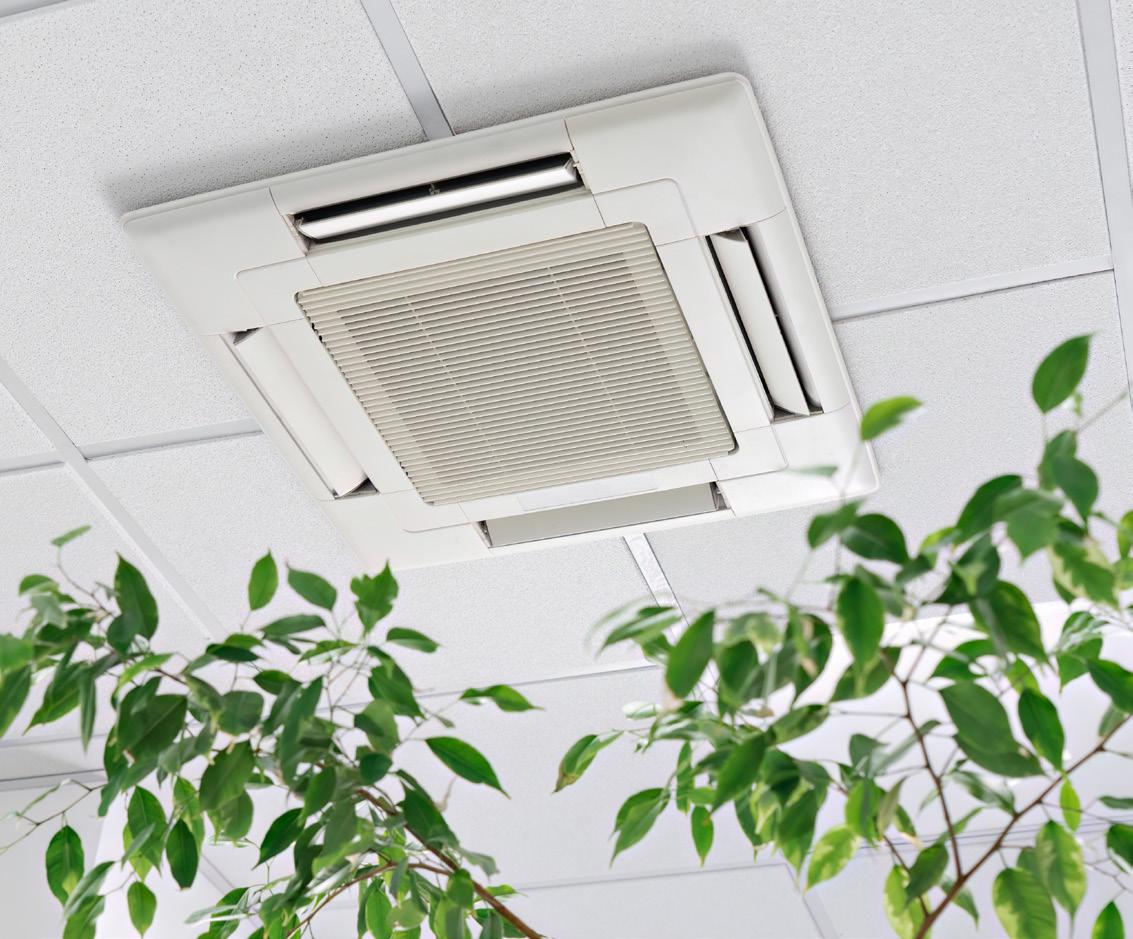
green wall that exploits Naturbo tech nology by absorbing the air impurities in the root zone of plants, to transform them into nutrients for plants. This means that it is possible to replace syn thetic chemicals and microbes in the indoor air with the healthy chemicals of nature. A Naturbo green wall pro vides offices, schools, hospitals and many other indoor facilities with the best possible indoor air quality. The ef fectiveness of this process is surpris ing: for example, a single Naturbo green wall device can purify the air of over 8,000 apartment plants, natural
izing a space the size of an average classroom. No ordinary green wall can do the same. Artificial intelligence re motely controls the operation of Naturbo and its environment via a re mote connection to a cloud server. Therefore, Naturbo's functions are constantly adjustable when conditions such as temperature or seasons change. In this way, people inhabiting the space always have the best possible indoor air quality: the fresh and healthy air of the Finnish virgin forests is brought to thousands of inhabitants in European cities.
50 OCTOBER 2022
AIR QUALITY

ORMA srl - Via A. Chiribiri 2, 10028 Trofarello (TO) Italy - Tel: +39 011 64 99 064 - aircontrol@ormatorino.it - www.ormatorino.com AIR CONTROL SANITIZER DISINFECTANT AGAINST VIRUS, BACTERIA AND YEASTS 3.000 SPRAYS WITH METERED VALVE DISINFECTION ACTION QUICK AND TESTED EFFICACY 500 ml 150 ml ONE-SHOT 250 ml
Among the main marketing tools, product quality is an essential one. However, it happens to run into "physiological disservices" and the ability to know how to manage them is fundamental
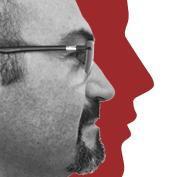
 Marco MontiFabrizio Pirovano
Marco MontiFabrizio Pirovano
Quality makes the difference
In the world of global market turbu lence, spasmodic innovation, offshore production, one wonders whether talking about an old and established concept such as that of quality still has a meaning. Probably not. And absolutely yes. It is a common fact that in products - and even more so in services - the first sales tool is customer satisfaction and that therefore one of the main market ing elements is quality. The search for quality therefore becomes an essential element for commercial success and its complexity in the context of services is amplified by some typical character istics of the services themselves: con textual production and consumption; differentiation in delivery; impossibility of standardization. It is therefore "nor mal" for those who provide a service to expect a certain amount of "physiolog ical disservice". Customers themselves know this and are willing to accept it.
THE "CULTURE OF SERVICE"

Therefore, the ability to manage disser vices becomes fundamental, not only thanks to a great commitment to mini
mize them, but by demonstrating to be able to recover the relationship with the customer when the disservice has oc curred. In essence, "make amends". In
52 OCTOBER 2022
MARKETING
this sense, the presence of a guarantee puts the products in an advantageous position and requires companies that provide services to consider the "culture of service" and the management of dis service as a widespread and transversal asset. Product quality or service quality as a means of customer satisfaction for commercial success. So far, even too banal. Unfortunately, the problem goes further. In a world in which the impor tance of the network has assumed such a weight as to upset paradigms valid until yesterday and in which the importance of the community has increased to the point of decisively influencing the mass approval of a product or service, atten tion to the search for quality according to criteria decided a priori by the com pany is no longer sufficient to guarantee the satisfaction of consumers, making it essential to concentrate on what the consumer perceives as quality. Let's think of a company that waits for a cost estimate for a longer time than the one promised. The provider's service will start to be perceived as poor from that moment. An unpleasant answer on the phone, a long wait before being heard are just some of the examples of per ception of the quality of the service that have little to do with the service itself, but through which the customer will inevitably judge the company. This also means that, probably, the “real” quality will be taken for granted, making the judgment of the supplier depend solely on the perceived one. To give an example, punctuality for a transport service or reliability for an electronic device are fundamental crite ria for judging the quality level achieved, but are rarely cited by customers as one of the strengths of the supplier. The reason is simple: they are aspects taken for granted (except when they fail). No one will ever say: “I flew with XY and I arrived on time”. The customer expects a quality that he considers obvious and expects to go further; it demands that its expectations be met (and if possible exceeded) through a quality that it per
ceives as superior, but which it is not al ways able to express as an explicit need.
WORD OF MOUTH IS BETTER THAN ADVERTISING
Unfortunately, the investments neces sary to improve the perceived quality of the service (training, staff) are sig nificant, while it is extremely difficult to demonstrate the benefits in advance (for example, in a planning phase). We think of the cases in which we ourselves received a service that went beyond our expectations. How much money have we happily spent more than ex pected with that company? It would be possible to cite many cases in which the quality of the products or services purchased are taken for granted and in which, instead, the perception of an ad ditional level of quality, which is hardly expressed by the customer, makes the difference. Obviously, customers will talk about these satisfying services or products, producing the most effec tive of advertising campaigns: word of mouth. Unfortunately, the customer is now used to high quality standards and is looking for an extraordinary experi ence during the purchase, coming to match that extraordinary with his con cept of perception of quality.
Investigating according to which quali ty standards customers will judge whether or not there is a gap between their expectations and what is received,
consequently investing in quality (real and perceived) and communicating it is an effort that customers demand in ex change for what they first did for us: they tolerated our mistakes, they risked their money and, sometimes, their rep utation. It is therefore understandable that customers do not allow us excuses and are not satisfied with our definition of quality. It is the customers who de fine our quality standards, which corre spond to the quality that they are able to perceive and unfortunately hardly express. After all, it would be enough to appropriate the secret of certain "ex pensive but good" professionals that we do not want to do without, if it were easy. Each of us knows and uses at least one of these "super experts" but we still wonder how they managed to convince us and our wallets that we cannot de prive ourselves of them. The problem is that we are perfectly aware of not being able to judge the real quality of their work, but we are very ready to express an opinion on the basis of parameters that are as personal as, often, little rele vant to its objective quality. On the in vestigation of the parameters on which our client will base his judgment, it is necessary to make a specific commit ment through the use of particularly so phisticated tools for understanding the individual. It is precisely on this that our studies and our work as trainers and coaches are based because these kinds of questions, if asked incorrectly, will almost never get the necessary an swer to differentiate us from others.
53
West Nile Virus A treatment against mosquitoes
Step by step, the necessary interventions to effectively combat the mosquitoes responsible for the spread of this pathogen, whose presence in Italy has increased in recent years

Alex Pezzin
Technical and scientific manager of Biblion Srl
PEST MANAGEMENT
For some years now, in the late summer period, the scenario of the fight against the spread of the West-Nile virus has entered its most crucial phase. Let's examine the strat egies adopted by the Emilia-Romagna Region which, this year, given the early circulation of the virus and the risk of an increase in infections, involves the municipalities, recalling which tools are available:
• antilarval activity;
• control and support for private activities;
• extraordinary interventions in case of outdoor events in the evening;
• maintenance of public parks;
• entomological and health monitoring.
Furthermore, in the Municipalities where viral circulation was greater, weekly adulticide treatments are carried out until mid-September in the envi ronments frequented by the elderly (for example the healthcare residences). For the regional plan for the surveillance and control of the so-called "arboviro sis", the regional council confirmed its economic commitment for 2022, al locating 1 million euros to all the local health authorities and municipalities that contributed to implementing mul tiple actions in the area to counter the spread and reduce the presence of com mon and tiger mosquitoes.
Already in June, the regional surveil lance system envisaged by the Arbo virosis 2022 Regional Plan highlighted the circulation of the West-Nile virus in mosquitoes of the genus Culex, the main vector of the virus.
The presence of the virus was verified in mosquitoes captured in the prov inces of Piacenza, Parma, Reggio Emil ia, Modena and Ferrara as early as the beginning of July, about 10 days earlier than 2021. The cases of incidence on humans, in mid-August, highlighted the positivity of 25 cases of neuro-inva sive form of the disease, with the first case of death of an elderly person (88 years old) in the province of Ferrara.
The risk that the Region wanted to avert is to repeat the data of 2018, the year in which the highest number of cases of neuro-invasive form of the disease were recorded, with 101 cases recorded: even then an early circulation of the virus was detected.
2022 summer season, however, was not characterized by a high population den sity of Culex: the monitoring data shown by the network of traps that capture and reveal the "numerical abundance" of the insect in the various provincial territories, after a peak reached in the week from 4 to 10 July revealed a nu merical decline until 8 August (bend ing curve), after which the trend started to grow again. The insect population in August was lower than the average of the five-year period 2013-2019, but it re mained advisable to keep our guard up especially by virtue of the finding of the virus in birds and mosquitoes even in urban areas. Viral circulation was not homogeneous throughout the region: on 10 August the areas most affected by the phenomenon were the lowland and foothills areas of the provinces of Pia cenza, Parma, Reggio Emilia, Modena, Ferrara and Ravenna.
HOW TO COUNTER THE SPREAD OF THE VIRUS?
All the municipalities of Emilia-Ro magna whose territory extends into the plains, foothills and hills, were asked to rigorously implement the anti-larval actions that they are responsible for. This means intensification of control activities, support for activities carried out by private individuals, planning of extraordinary preventive interventions with adulticides if an event is planned that involves the meeting of many peo ple (over 200 presences) in the evening hours in outdoor areas, adequate main tenance of public parks, with particular attention to the removal of potential eliminable larval outbreaks and to the treatment of those that cannot be elim inated.
In the most concerned provinces, the
warning level has risen and adulticide treatment procedures became neces sary, on a weekly basis, until mid-Sep tember, even in places frequented by over-60s, such as for example hospitals, social welfare and healthcare facilities. It was believed that the protocol adopted was also sufficient because if a person is infected and remains in quarantine at home, disinfestation in terventions around the residences of the sick are not necessary, given that an infected person cannot infect other people. This fact is reassuring because the neuro-invasive form occurs when presumably 15-20 days have passed since the infection, a period that would be extremely viral if the infected were potentially dangerous.
IMPORTANCE OF COMMUNICATION
The advice for citizens, especially in the provinces affected by viral circula tion, is to protect themselves from bites, especially in the evening and at night when the common mosquito is active, by applying skin repellents and adopt ing the appropriate precautions at home using mosquito coils, electro-diffusers, mosquito nets. It is then necessary to eliminate all possible water stagna tions and periodically use larvicidal products: mosquitoes only need a little stagnant water to deposit their eggs and reproduce.
FROM THE POINT OF VIEW OF THE OPERATOR
To comply with the "extraordinary ac tions" (especially in the late summer period) a not insignificant organiza tional commitment is required but the goal is to protect the population with precise technical interventions, target ed and carried out with the utmost pro fessionalism through adequately tested equipment and with specific insecticide products always mixed at the correct dilution and in compliance with the instructions, as per the label. It is also necessary to dialogue with citizens by
55OCTOBER 2022
giving them correct information, mo tivating them to collaborate and adopt self-defensive behaviors.
EXAMPLE OF AN EXTRAORDINARY ADULTICIDAL TREATMENT
The checks to be made before carrying out the treatment are the following:
• no matter how obvious it may appear, it must be ensured that there is a need for intervention, as errors may occur in the information flows and some time may have elapsed between reporting and intervention;
• regulation of the use of outdoor space; it is a fundamental aspect for the safety of citizens and pets.
Technical aspects:
• adoption of the most suitable equipment to obtain sufficient knockdown power without inappropriate drifts;
• verification of the proper functioning of the equipment (this is an aspect not to be overlooked, technicians in some cases tend to do so);
• flow rate adjustment according to the forward speed. The dispensing pressure also has its importance as it is the variable that determines the diameter of the micro-drops dispensed;
• checking the weather conditions, which must allow the work to be carried out smoothly.
BRIEF DESCRIPTION OF THE TREATMENT
• average diameter of the droplets to be dispensed taken from the use and maintenance manual ≈ 20-30 μm (1μm = 0,001 mm);
• average vehicle forward speed ≈ km/h speed also verified with a GPS in order to have a technical feedback even in real time on the quality of the intervention performed (time, speed of the vehicle, routes and degree of coverage of the treated area);
• the biocide used was based on natural pyrethrum extract;
• medium-low dispensing volume;
• two technicians assigned to carry out the work (a foreman with
responsibility for the correct execution of the treatment, for verifying compliance with safety regulations and for the relationship with citizens and a techniciandriver responsible for both the proper functioning of the vehicle and the equipment and all parameters necessary to respect the dosages).
GENERAL CONSIDERATIONS
It is important to consider the flight activity of the target mosquito spe cies. For example, for Aedes albopictus, characterized by a largely diurnal activ ity, the treatments should be carried out
In the most concerned areas, the warning level has risen and adulticide treatment procedures became necessary, on a weekly basis

56 PEST MANAGEMENT OCTOBER 2022
with spraying done in the early hours of the evening. Against Culex pipiens, on the other hand, active throughout the night, the treatments maximize their effectiveness in this time band; finally, against populations of Aedes caspius, Ae. vexans and Ae. detritus the maximum ef fectiveness will be obtained with treat ments at dusk or at the end of the night. In certain situations, such as in the case of proven viral circulation and in areas of limited extension with dense vegetation, it may be convenient to
rier to invasion by mosquitoes from outside. In this type of treatment, the spraying must be directed towards the vegetation up to a maximum height of about 3-4 m, taking care to homo geneously spray the green surface without creating drips on the ground. Residual effect treatments have the critical point inherent in their residu ality, which could interact more with non-target arthropods. Before decid ing on the intervention, particular at tention must be paid to the presence

has been carried out. These products must bear the words “Biocidal product Authorization of the Ministry of Health n. IT /… / 00… / AUT (pursuant to EU Reg. N.528 / 2012) or Medical Surgical Unit Registration n… of the Ministry of Health (pursuant to Presidential De cree 392/1998)".
There would be many other aspects to investigate and deepen, what may seem a fairly simple job, from an executive point of view, actually masks behind it a high series of technical, regulatory,
evenly spray all the vegetation with the insecticide mixture in order to create a deposit on the leaves (residual kill ing treatment): the intent, in addition to acting on the specimens sheltered in the fresh microenvironment creat ed by the vegetation, is to exploit the residual repellent or lethal action of insecticides by creating a sort of bar
of blooms in progress and therefore of pollinating insects whose presence may make it necessary to postpone the intervention.
All products used and present on the Italian market for the fight against mos quitoes must necessarily be Biocides or MSD for which a safety assessment for human health and the environment
functional and evaluative aspects such that it is possible to to affirm that, today, adulticidal treatments against mosqui toes represent one of the most difficult operative parts. In addition to the clas sic and always recommended common sense, it is therefore a duty to pour the maximum dose of virtuous profession alism into the field.
57OCTOBER 2022

 Spray Team srl
by Cristina Cardinali
Spray Team srl
by Cristina Cardinali
On the market today
Technology, research, development: the latest news from the cleaning world
 KUBI ECOLABEL
KUBI ECOLABEL
The combination of all the aspects underlying the principles and values of Falpi begins with conceiving one's product in "Eco-Design", that is to produce articles that combine high quality, innovation, refinement, basing the design on sustainability and respect for the environment. This virtuous approach is now the basis of the new Falpi project: the Kubi trolley with EU Ecolabel certification.

HIGH PERFORMANCES WITH MIKRO K
The Mikro K wet-mop now has the Ecolabel certification which guarantees its environmental performance. Its matrix microfiber composition (18% polyester, 82% polyamide) guarantees excellent cleaning capacity, while the Loopfix fastening fabric gives excellent resistance to washing. Its particular structure facilitates the release of impurities during washing while maintaining the effectiveness of the subsequent pre-impregnation speeding up the process.

THE RIGHT AMOUNT OF SANITIZER
Hygenia, which has always been at the forefront in everything concerning the concrete answers to the needs of hygiene and safety in the field of professional cleaning presents the dispenser Surf. Available in the table, wall and floor version, it delivers the right amount of sanitizer and is easy to use and refill. Finally, it guarantees safety and hygiene, thanks to the touch technology that reduces the contact of the hands with its surfaces, proportionally decreasing the probability of contamination with pathogenic microorganisms and allowing you to clean your hands quickly and without rinsing.
OPTIMIZING CLEANING ACTIVITIES
Hy-genio is a hardware component that transforms the Mop into a system capable of capturing the actual cleaning activity carried out within a structure. Hy-Genio optimizes cleaning activities, mapping the movements of the Mop and the square meters actually cleaned. So, it provides to optimize of resource and budget management, Time savings, Validation of clean areas, Simplify and monitor performance analysis, Optimize workload planning.
FALPI SRL falpi.com

Falpi has clear ideas: to bring the dynamism and desire to innovate of a young and motivated team to the world of professional cleaning equipment, always faithful to the quality of “Made in Italy” and environmental sustainability. Falpi products are designed for cleaning companies, hospitals, companies, communities, hotels and are made with recyclable materials.
HYGENIA SRL hygenia.it
Hygenia is a constantly evolving, reactive company, ready for innovation and to take care of the hygiene of the environments and the quality of life of people. It is always guided in its engineering activities by the search for quality and design. New divisions have been added over the years to offer products and services increasingly focused on the evolution of customer needs.


MARKET REVIEW 60 OCTOBER 2022
KEMIKA SPA kemikaspa.com
To spread a culture of cleanliness, in total respect of the environment, Kemika specialized itself in the formulation and production of chemical products certified CAM / Ecolabel / BIO C.E.Q. Kemika has five inner laboratories, who are daily concerned with quality control of raw materials and finished products. Here the Research & Development is considered one of the main missions of the company, where the chemists work incessantly on the performance ratio of the formulated and its impact on the environment, both on new articles and on those already in the range.
STAR: DESCALING DETERGENT
The product Star, descaling detergent for toilets, enables Kemika to develop a “Culture of cleanliness” and to focus its Mission on the total respect of the environment. Star, besides CAM and Ecolabel Certification, is awarded with the Bio C.E.Q. Certification as well.


The organic components used in the formulation derive from renewable sources. The product is made only with raw materials coming from natural sources. No heavy metals and phosphorus derivatives and limitated presence of allergens. No animal tests have been performed on raw materials.
SPACE FOR FLOORS
The product Space, neutral detergent for floors, enables Kemika to develop a “Culture of cleanliness” and to focus its Mission on the total respect of the environment. Space, besides CAM and Ecolabel Certification, is awarded with the Bio C.E.Q. Certification as well. The organic components used in the formulation derive from renewable sources. The product is made only with raw materials coming from natural sources. No heavy metals and phosphorus derivatives and limitated presence of allergens. No animal tests have been performed on raw materials.
KLINDEX SRL klindex.com
Klindex was established in 1988 from Bibiano brothers Ercole and Ennio, who had the idea of revolutionizing the way of smoothing and polishing marble and stone floors. They designed and patented the Levighetor floor polishing machine which in a short time became famous all over the world. On the wave of the success of this machine, Klindex has continued to develop new projects by creating new technologically advanced machines. Klindex is also continuously engaged in the research and the development of new technologies with particular regard to respect for nature.

KRISTAL REVOLUTION: CLEAN AND SHINY
Kristal Revolution is the new and revolutionary system to polish and maintain glossy and “not slippery” any kind of surface including concrete, marble, granite and engineered tiles floors. Easy to use, it is the best way to polish, restore, maintain and create a safe flooring with high friction coefficient. It is the ideal machine for keeping large areas clean and shiny. The best to use on shopping center, airport, hotels, bank etc.
The main future is: powerful motor 4 hp, working width 60 cm, ergonomic handle, dust collector to work “dust free”, pump and dispenser for products. On request led light.
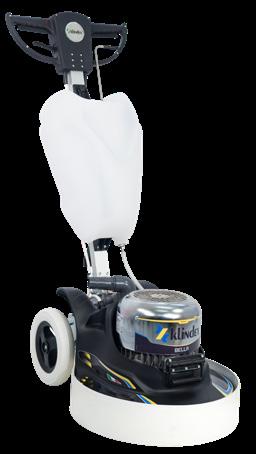
BELLA FOR CLEANING AND POLISHING
Bella is the innovative multifunction single disc born in Klindex home. With motor 4 hp is the most powerful floorcare machines for cleaning and polishing any kind of floors. It is a multifunction floor care machine depending on the accessories with which it is equipped. Equipped with brushes 20 inch it cleans floor better and faster than normal machines 17 inch.
Equipped with Planetary Sander it becomes Bella Sander, a high-performant sanders for wood floors. Equipped with Planetary Stone it becomes Bella Stone for polishing marbles and stones.
Its main features are: ergonomic handle with hand protection, sturdy frame, body carcase in shockproof and scratch-proof polyurethane material, release of the water in the center of the brush, height adjustment of the wheels.
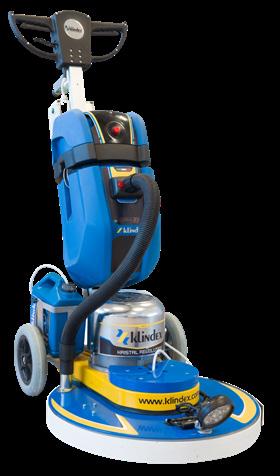
61OCTOBER 2022
For over 45 years Comac has been designing and producing machines for professional floor cleaning including floor scrubbers, sweepers, single disc machines, vacuum cleaners and sanitizers able to solve cleaning problems in different conditions of use and on any type of surface. Challenges always get bigger in the cleaning market, but Comac had the capacity to innovate and rejuvenate itself.


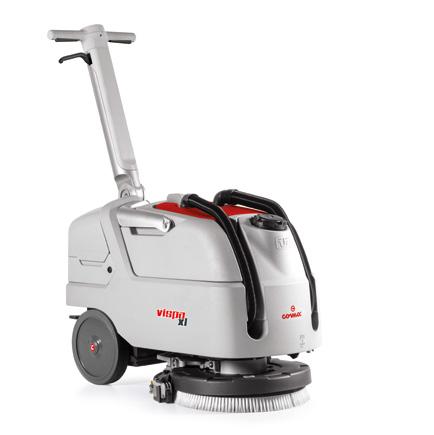
WALK-BEHIND FLOOR SCRUBBER
Antea is a high performing, easy to use, walk-behind professional floor scrubber. Ideal for the professional cleaning of floors in offices, hospitals, shops, public buildings, restaurants, hotels, sports centers, supermarkets and production facilities.
Robust, resistant and reliable, the professional floor scrubber Antea have been designed to improve productivity and reduce the cost of cleaning operations. Antea's technical characteristics and functions make it a professional floor scrubber suitable for both maintenance and heavy duty cleaning of floors up to 2200 sq.m. The Antea 50 BT CB version is the first, among Comac’s products, to be included in the Carbon Footprint Italy program, and for this reason bearing the CFI mark. Measuring the carbon footprint of this scrubber dryer allows us to have real and third-party verified data on its performance with respect to CO2 and climate change.
COMPACT FLOOR SCRUBBER
Vispa XL is a powerful, cutting-edge floor scrubber, but is also extremely easy to use and maneuverable. With a 43 cm working width and an exclusive design, it fits perfectly into the existing range, becoming a new ally in maintenance and deep cleaning operations in small and medium-sized spaces, to tackle even the most stubborn dirt.
Despite its small size, the machine is equipped with the same technology as the larger models, enabling you to complete your fleet with a compact, high-performance solution.
Robust and reliable, Vispa XL is also practical and easy to use so suitable for cleaning floors in the HoReCa, cleaning contractors, retail, well-being and sports sectors and all restricted areas that require power and excellent performance. Available in the disc version with traction (BT) or without (B) or in the orbital version with traction (BTO). All versions are also available with lithium batteries.
AR-CO has been producing detergents for the professional cleaning line since 1993, covering all the different needs of customers in the field of cleaning environments: Industrial, Food, Hospital, Healthcare, Hotel, School, Public and Private. The entire production process is carried out in the establishment in Medolla (MO – Italy) through a series of high-tech production lines. AR-CO CHIMICA is equipped with a research, development and analysis Laboratory, directed by a team of chemical managers.

 AR-CO CHIMICA SRL arcochimica.it
AR-CO CHIMICA SRL arcochimica.it
CLEANING
AT THE RIGHT DOSAGE
Aladin is an automated dosing system created with the aim of providing a highly technological and safe solution in the cleaning sector. The Aladin system allows, through the new Aladin web platform, the preventive programming of the product dilutions prepared based on the activities carried out on the construction site and according to the needs of the customer. Once the configuration is complete, this is sent to the machine which, immediately, through an electronic scale managed by a tablet, delivers super concentrated chemical product and water according to the container and the programmed dosage. The electronic scale allows to always obtain the correct dilution of the product in the bottle whether it is completely empty or contains product residue from the previous day. The Aladin system completely eliminates the chemical risk as the super concentrated product canisters are locked in a compartment under the dosing system that is not accessible to operators except those authorized. The product mixed and diluted by the Aladin system loses all symbols of danger making it harmless for the user. Aladin is ideal for multiple sectors: Healthcare, Welfare, Hospitality, School and University, Wellness, Commercial, Civil and Industrial.
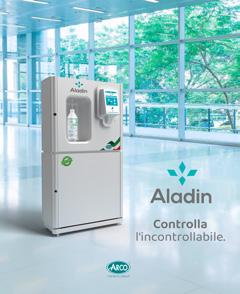
SUSTAINABLE DETERGENTS
In calls for tenders, cleaning companies are increasingly required to include environmentally friendly products. It is therefore necessary for companies to choose professional products that give a guarantee of effectiveness and at the same time with a low environmental impact. Amazzonia is a concentrated detergent for the maintenance of floors. Ideal for any cleaning mode: with mop, mop or scrubber dryer. All the products in our Ecolabel line are characterized by a reduced environmental impact, sustainable use and a substantial reduction in packaging.
MARKET REVIEW
COMAC SPA comac.it
62 OCTOBER 2022
HYDRO-REACTING SMOKE GENERATOR
Cyperfum is the ready-to-use hydro-reacting smoke generator insecticide effective against flying and crawling insects based on Cypermethrin and Pyrethrum extract. Characterized by a flame-free ignition and gas emission, Cyperfum does not leave stains or deposits on furniture or unpleasant combustion odors. The presence of a dosed water sachet for the correct triggering of the reaction inside the package makes it a product with a simple and intuitive use.
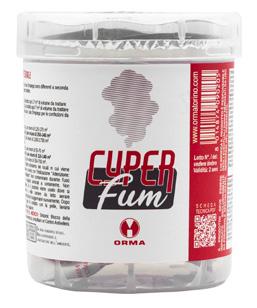 ORMA SRL ormatorino.com
ORMA SRL ormatorino.com
ORMA is an Italian company with thirty years of experience in the field of professional solutions for environmental hygiene: pest control and air control require continuous technical, scientific and regulatory updating. ORMA puts all the expertise of its team at the customer's service, providing products developed after careful research: effective, functional and durable.

AIR CONTROL SANITIZER® PMC

Air Control Sanitizer® is a line of ready-to-use aerosol disinfectant cans based on quaternary ammonium salts, effective against bacteria, yeasts and viruses for use in environments, on objects and surfaces. It is available in three different formats (500 ml, 250 ml with metered valve and 150 ml with total release valve) to adapt to the different needs. Air Control Sanitizer® complies with standards for application in the medical, food, industrial, domestic and institutional areas: EN14476 and EN16777 for effectiveness on encapsulated and some non-encapsulated viruses; EN 13697: 2015 + A1: 2019 of bactericidal and yeasticidal efficacy; EN1276: 2019 of bactericidal efficacy; EN1650: 2019 of yeasticidal efficacy.

NATURAL SANITIZER
Thanks to Timos, Parodi & Parodi introduces a new concept of sanitizing inspired by the principles of sustainability. 100% natural, made of thyme extract and other vegetable components, giving to the product its sanitizing properties. It can be used on all surfaces (home, car, office, clothes etc.), it does not spot and it spreads a good smell of clean and fresh all around.
DOUBLE-ACTION SINK PLUNGER
Superasco is an invention by Giuseppe Parodi, the founder of Parodi & Parodi. It is a double-action sink plunger. Not a classic one. Its strong string and its movable handle guarantee the maximum adherence to the sink with the minimum effort.
How to use it: you should apply the plunger to the sink, closing the side holes of the sink (if any) with a hand. You can easily remove the plunger rotating the handle. Doing this, you’ll get the maximum power from Super Asco.
Parodi & Parodi is an Italian company born in 1969 and producing household cleaning items, recognized for the Patent of its sink plunger

It is specialized in 7 lines of products: cleaning, ironing, laundry, kitchen, sewing, shoes, it is known for the quality of its products and its service (speed of orders delivery, exposition on selling points, agents on the territory). The packaging is very attractive, coordinated in its divisions and in 4 languages. The company is in expansion out of its boundaries now, looking for new distributors all over the
 PARODI&PARODI SRL parodieparodi.it
PARODI&PARODI SRL parodieparodi.it
63OCTOBER 2022
DISPENSING NO-TOUCH SYSTEM
Soavex Professional is the new dispensing system by Paperdi ready to meet the growing needs of the market in terms of guaranteed hygiene, cost of use and autonomy. A range of no-touch dispensers with a modern, innovative, technological and practical design. The ideal solution to guarantee concrete benefits to your business by combining maximum efficiency, high autonomy, cost control in every sector.

Paperdi manufactures and distributes Tissue Paper for hygienic, sanitary,cleaning and industrial application. The company thanks to the integrated cycle realizes products with high quality of raw materials and offers a range of products made of pure cellulose and recycled paper: Kitchen and Hand towels rolls, Medical rolls, Toilet paper, Interfolded hand towels. High quality coupled with a consumer-oriented policy have made Paperdi a leading company in the National market with a model of development that can reconcile business growth with customer satisfaction, value creation and environmental protection. With the folded hand towels ( fold V and Z ) are highlighted this two values, product 100% sustainable and recyclable from the sheets to the paper packaging (no more in plastic) to the carton. A product that facilitates the dispenser recharge process and helps the operator to do his work in a faster way, using only one garbage to dispose of the waste. Flexibility of use, attention to the environment, simply way of use are for sure the key of the success of this product.
SANITIZING ESSENCE
Magica Essenza, synonym of Rubino Chem Sanitizing Essence, is the brand identifying the highly concentrated polyfunctional formulation with strong sanitizing action and neutral pH used to cleanse, remove germs and bacteria with mechanical action, dust, perfume and deodorize environments and surfaces.

The Magica Essenza formulation was designed to meet the needs of professional users. The registered Trademark and the formulation have maintained over time their peculiar high quality and identity recognized and appreciated by our end users.
The iconic name and its function have always linked the universe of cleaning and the most demanding customers.
Rubino Chem is one of the most important companies in the Italian chemical industry. Rubino Chem offers innovation and technology in a wide range of products for professional cleaning, ensuring high quality. The company has a vanguard R&D department. Our keyword is excellence.
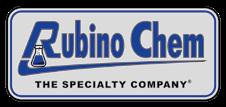
POLYFUNCTIONAL FORMULATION
Olè Ressenza is the new brand identifying the highly concentrated polyfunctional formulation with strong sanitizing action and neutral pH used to cleanse, remove germs and bacteria with mechanical action, dust, perfume and deodorize environments and surfaces.

The Olè Ressenza formulation was designed to meet the needs of professional users. The registered Trademark and the formulation have maintained over time their peculiar high quality and identity recognized and appreciated by our end users.
The iconic name and its function have always linked the universe of cleaning and the most demanding customers.
MARKET REVIEW
PAPERDI SRL paperdi.it
RUBINOCHEM SRL rubinochem.it
64 OCTOBER 2022
SYNCLEAN SRL syncleanservice.com

It has been over 25 years since Synclean had the idea of creating a database of accessories and spares for industrial cleaning machines. Modern and dynamic company but with a high level experience and specific know-how in the world of industrial cleaning machines, Synclean offers a wide choice of suction motors, squeegee rubbers, brushes, accessories and consumables that satisfy every request.
VACUUM MOTORS

The company promoters, after acquiring different experiences in the market of the industrial cleaning machines manufacturing since 1976, decided to establish the Synclean company aimed at creating not only a complete line of cleaning machines and accessories but also offering a complete service Door to Door to their Distributors. Leader in the distribution of vacuum motors, Synclean exports to most of the European, Arabic, Far East and South America Countries, total 57 countries. The foreign turnover represents about 85 % of the total. Thanks to a deep knowledge of all of the Industrial Cleaning Machines, in addition to its own brand MAXICLEAN, Synclean can supply spare parts and accessories from worldwide leading manufacturers : squeegee rubbers, pads, brushes, batteries and chargers.

SPRAYTEAM SRL sprayteam.it

Spray Team design, builts and sale equipment and machines for urban disinfestation and disinfection. In mid-2019 signs a partnership agreement with Gate Srl, a university spin-off and an innovative start-up, which has perfected the electrochemical technology, capable of generating large volumes of highly disinfecting water, used for urban disinfestation and in environmental sanitation. Spray Team has also developed the atomizers for the atomization of electrolyzed water, designing specific nozzles capable of obtaining dry air.
SERIES OF ATOMISERS
The Elite series of atomisers has been created to satisfy the needs of our most demanding customers, combining attractive, functional and safe property. The compact dimensions and the possibility of customization through various features and engines make it perfect for any use, from the simple "antimosquito" intervention to more specific treatments for trees and considerable heights. Elite, thanks to its easy use and its great versatility, is the perfect atomizer both for experienced exterminators and for those who approach this universe for the first time.
NEBULIZATION OF HYPOCHLOROUS ACID
Spray Team presents, in collaboration with Gate and Hypogreen, AWS (Automatic Water Based Sanitizer), the first automatic, complete and portable system for ultrasonic production and nebulization of hypochlorous acid: a sanitizer which has also been approved as a disinfectant and which uses a mixture of water and salt as a base. Thanks to the electrolysis process, this mixture acquires its properties of protecting against viruses, bacteria, molds and spores, and is automatically distributed throughout the room, setting the height and square meters of the environment.
AWS is therefore ideal for small environments, such as wagons, shops, hotels or restaurants. It does not pollute, does not generate waste and does not cause dermatological or respiratory damage, as confirmed by research from the University of Ferrara: it can be employed without any contraindication also when the staff is in the room.
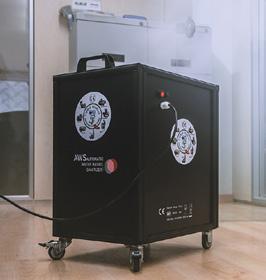
65OCTOBER 2022
Tenax International is the first company in the world dedicated entirely to the production, distribution and support of eco-friendly, low-voltage 100% electric machines for street clean ing and sanitation. With over 35 years of experience, incomparable technical ex pertise and over 700 ma chines sold and supported in more than 42 countries over 5 continents, Tenax is specialised in the creation
of cutting-edge machinery powered by clean energy, with genuinely extraordi nary performance. Tenax is a young and dynamic com pany staffed by passionate people keen to leave their mark, where every new challenge is seen as an op portunity for improvement, and where each individual customer’s requirements are listened to carefully and attentively in order to offer them innovative and cus
tomised solutions which allow access to quiet, ef fective and zero-emissions road cleaning and sanitisa tion solutions.

100% Electric Reliability
Tenax International is syn onymous above all with 100% electric reliability. Thanks to over 20 years’ experience in the elec

Electric cutting-edge machinery www.tenaxinternational.com
tric road sweeping sector, with over 700 electric road sweepers sold in 42 coun tries over 5 continents, Tenax is able to guaran tee the highest levels of performance for our vehi cles at all latitudes, with custom solutions to meet each and every customer’s requirements. This is why Tenax International is now a partner of some of the largest European public and private bodies, trust ed by major cities such as Paris, Brussels, Bergamo, Naples, Taipei, Melbourne, Barcelona, Bilbao and many others.

100% Electric Sweepers & Flushers





MACHINES
sponsored content




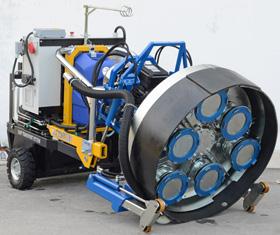

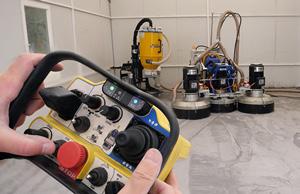



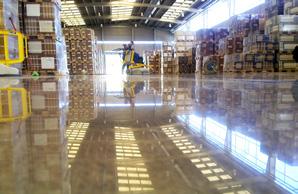

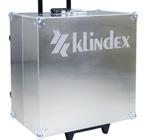
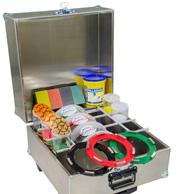



KLINDEX IS THE CHOICE OF TOP FLOORING PROFESSIONALS Floor grinders • Dust extractors • Diamond tools • Burnishing machines • Chemicals • Floor Solutions Klindex s.r.l. SS 5 Tiburtina Valeria km209+200 - Manoppello (PE) Italy | Tel +39 085 859 546 | www.klindex.com - info@klindex.it visit our YouTube




































































































































































































































































 One piece hand scoop
One piece hand scoop














 Marco MontiFabrizio Pirovano
Marco MontiFabrizio Pirovano





 KUBI ECOLABEL
KUBI ECOLABEL














 AR-CO CHIMICA SRL arcochimica.it
AR-CO CHIMICA SRL arcochimica.it

 ORMA SRL ormatorino.com
ORMA SRL ormatorino.com




 PARODI&PARODI SRL parodieparodi.it
PARODI&PARODI SRL parodieparodi.it







































